Remaining competitive in a rapidly changing world.
Disruptive technology improves efficiency and sustainability.
Siemens supplies Arkansas steel mill with new system.
How software will enable steel’s green transformation.
DIGITALIZATION: BUILDING FACTORIES OF THE FUTURE

www.steeltimesint.com Digital Edition - August 2023 - No.27 DIGITALIZATION ARTIFICIAL INTELLIGENCE DECARBONIZATION INNOVATIONS SPECIAL
Since 1866


CONTACT US: www.solarturbines.com, +41 91 851 1511 (Europe) or +1 619 544 5352 (US) infocorp@solarturbines.com ONE DAY IT COULD BE LIKE THIS BETTER ENERGY RECOVERY LESS CO2, HIGHER RETURN Hydrogen Off Gas High hydrogen, high CO, low or high BTU - Solar Turbines designs and manufactures gas turbines in combined heat and power applications with wide fuel capabilities to help our customers improve their bottom line and CO2 footprint. Syngas (H2 + CO)
Front cover photo courtesy of KOCKS
Successful commissioning of RSB® 370++/4 in China. Steel producers can rely on KOCKS’ expertise and innovative technology solutions.
EDITORIAL
Editor Matthew Moggridge
Tel: +44 (0) 1737 855151 matthewmoggridge@quartzltd.com

Assistant Editor Catherine Hill
Tel:+44 (0) 1737855021
Consultant Editor
Dr. Tim Smith PhD, CEng, MIM
Production Editor Annie Baker
Advertisement Production
Martin Lawrence
SALES
International Sales Manager

Paul Rossage paulrossage@quartzltd.com
Tel: +44 (0) 1737 855116
Sales Director
Ken Clark kenclark@quartzltd.com
Tel: +44 (0) 1737 855117
Managing Director
Tony Crinion tonycrinion@quartzltd.com
Tel: +44 (0) 1737 855164
Chief Executive Officer Steve Diprose
SUBSCRIPTION
Jack Homewood subscriptions@quartzltd.com
Tel +44 (0) 1737 855028
Fax +44 (0) 1737 855034
Steel Times International is published 12 times a year (including four digital issues) and is available on subscription. Annual subscription: UK £215.00 Other countries: £284.00

ISSN0143-7798
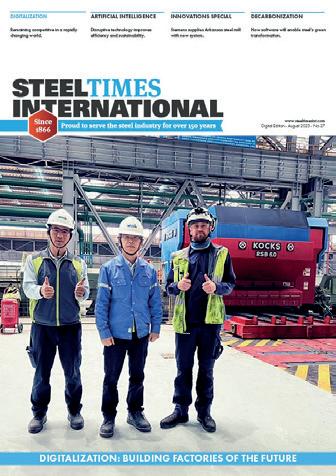
1 www.steeltimesint.com
CONTENTS – DIGITAL EDITION AUGUST 2023
Other
3 years subscription: UK £431.00 Other countries: £595.00 Single copy (inc postage): £47.00 Email: steel@quartzltd.com Published by: Quartz Business Media Ltd, Quartz House, 20 Clarendon Road, Redhill, Surrey, RH1 1QX, England. Tel: +44 (0)1737 855000 Fax: +44 (0)1737 855034 www.steeltimesint.com Steel Times International (USPS No: 020-958) is published monthly by Quartz Business Media Ltd and distributed in the US by DSW, 75 Aberdeen Road, Emigsville, PA 17318-0437. Periodicals postage paid at Emigsville, PA. POSTMASTER send address changes to Steel Times International c/o PO Box 437, Emigsville, PA 17318-0437. ©Quartz Business Media Ltd 2023 2 Leader by Catherine Hill. 4 News round-up Five pages of global steel news. 11 Innovations New products and contracts. 14 Future Steel Forum 2023 Details of the upcoming Forum. 18 Innovations special Siemens supplies ‘motion picture’ at steel mill. 21 USA update Trading: a case of fair or free. 23 Latin America update Offshore wind energy: Brazil’s new player? 25 India update Fuelling the fire. 28 Decarbonization Pursuing greener operations in the steel industry. 30 Artificial intelligence Data analytics and AI for energy and emission control. Digitalization 36 Adapting to demand. 41 Enabling production efficiency. 44 From manual to digital. 48 Perspectives Q&A: Metsen Measuring up. 50 History Pictures of history. 36
2 years subscription: UK £387.00
countries: £510.00
Unmanning the factory

In Tim Burton’s seminal take on the Roald Dahl classic, Charlie and the Chocolate Factory, Mr Bucket, father of the eponymous Charlie, is laid off from his job at the toothpaste factory, with the culprit being a shiny red robot that replaces his work as toothpaste cap screwer-onner. This holds major plot implications for the Bucket family; first and foremost, the Buckets have less money than the less they were already struggling by on. The holes in the roof gape wider, cabbage soup is served sans bread.
A subtler commentary, however, lies in the glittering metal arm of the Smilex 2000 – of automation holding the capacity to lower costs and increase efficiency – while rendering its human precursor obsolete. The rise of digital manufacturing in the steel industry has certainly achieved its mission of improved productivity, safety, and capex, but the implications on the manual labour force once so intrinsic to the material creation of steel remain unknown.
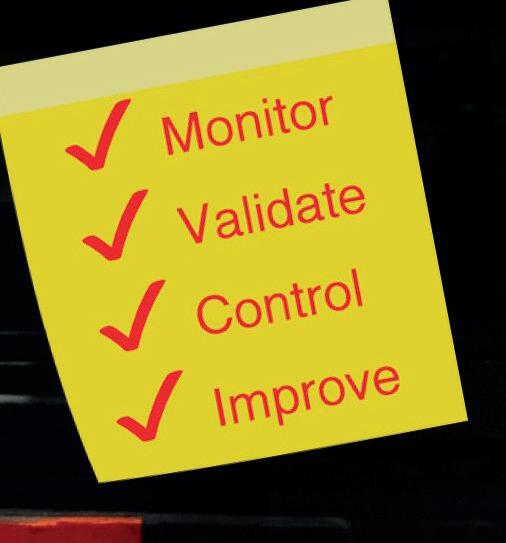


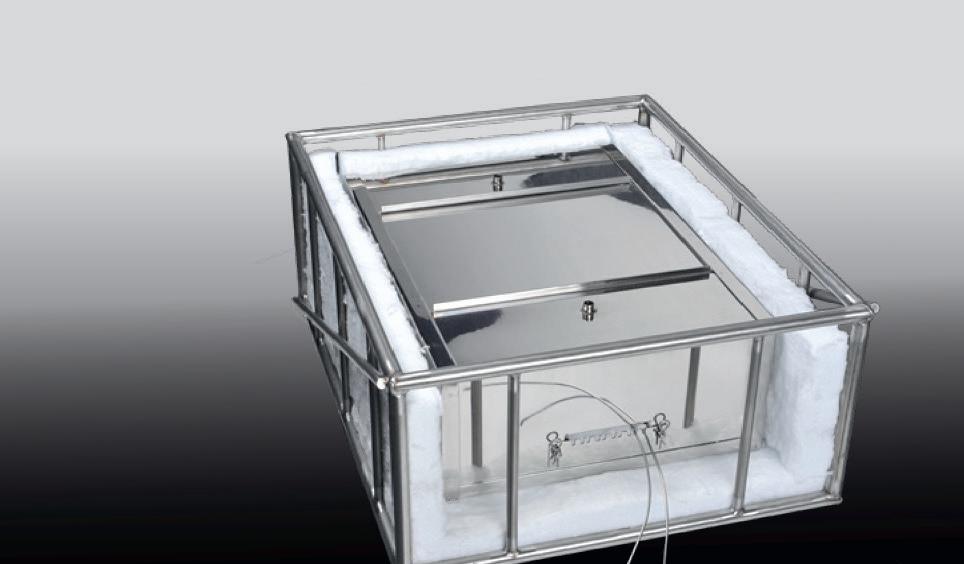

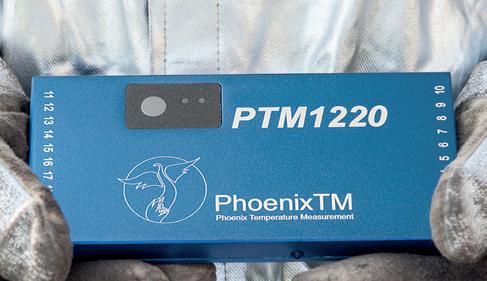
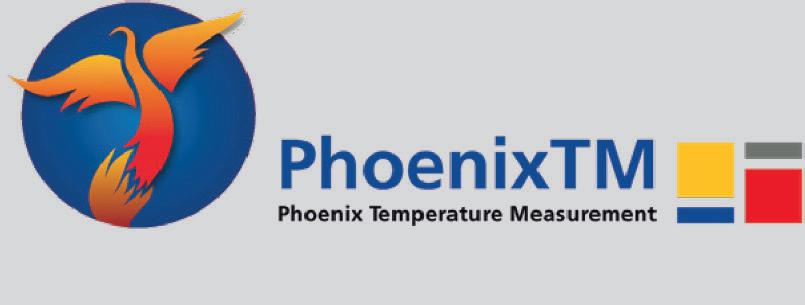






Digitized plants offer a multitude of advantages, particularly given the dangerous, extreme, and often


unpredictable environment of a steel mill. However, the culture of a blue-collar labour force is ingrained deeply into the skin of industrial towns. The aftermath of a digitalized production line strikes parallels with Thatcherite-era mining communities that were no longer required to mine – causing long-term economic decline, mass unemployment, rising crime rates, and crises of personal and political identity.



After Charlie secures his golden ticket, bests the other ‘rotten’ ticket winners, and eventually moves into the factory alongside his family, Mr Bucket finds a new job as the repairman for the very robot that replaced him. Like Mr Bucket’s eventual recompense, the automated era of manufacturing will in turn, demand new workers. Gaps will be filled, and spaces created, but the seismic shift in culture and environment, whether it be a Smilex 2000 laying off the parent to a chocolate mogul, or a sensor that detects flaws that were once inspected by the human eye, will have far-reaching repercussions that extend beyond streamlined production into territories uncharted, and unmanned.

2 www.steeltimesint.com LEADER
Catherine Hill Editorial assistant catherinehill@quartzltd.com
Digital Edition - August 2023 Temperature Profiling Solutions In the Steel Reheat Industry Comprehensive • Passes through furnace with Slab • Get an accurate Slab temperature profile • Measurement at up to 20 points • Live 2 way radio communications Safe • Safe system installation without production delays • Reliable protection of data logger up to 1300°C Easy • Optimise your process accurately • Validate your furnace mathematical model. PhoenixTM GmbH Germany info@phoenixtm.de PhoenixTM Ltd UK sales@phoenixtm.com PhoenixTM LLC USA info@phoenixtm.com Benefits • Optimise furnace programs • Save energy and increase production • Obtain optimal drop out temperatures • Minimise scale build up • Prevent hot roller wear & tear
experience counts ! www.phoenixtm.com
Where
PROFILEMASTER® SPS Profile Measuring System
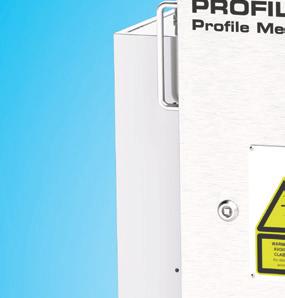


The PROFILEMASTER® SPS is a light section measuring device for measuring contours and dimensions on profiles of all kinds in cold and hot steel applications.



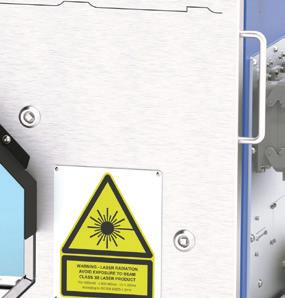


Benefits:
Maximum measuring accuracy thanks to temperature-stabilized measuring systems




























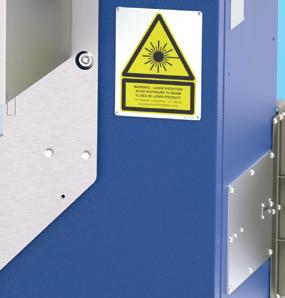



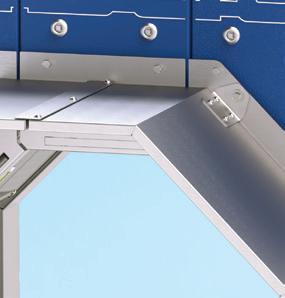






Shape fault detection (SFD) thanks to high sampling rate
High-precision measurements

Detects process problems at an early stage




Fast maintenance and easy cleaning

Zumbach Electronic AG | Hauptstrasse 93 | 2552 Orpund | Schweiz Telefon: +41 (0)32 356 04 00 | Fax: +41 (0)32 356 04 30 | sales@zumbach.ch | www.zumbach.com 4 - 8 Number of cameras min 5 Min. object diameter (mm) max 720 Max. object diameter (mm)
AM/NS India, and Festo India, manufacturer and supplier of automation technology and technical education, have partnered to develop an education initiative, with an emphasis on manufacturing and sustainability. The project, named New Age Makers Institute of Technology (NAMTECH), aims to deliver an integrated model of high-quality engineering and technical education, and will begin operating at an interim campus in August 2023.
Source: Realty Plus, 8 July 2023.
ArcelorMittal has won its appeal against the closure of its Fos-sur-Mer steelworks in France. The labour inspectorate ordered ArcelorMittal to close the site on 19 June, but the steelmaker won its appeal to the Marseille Administrative Court to maintain activity at the site. The court said ArcelorMittal had already taken several measures to clean the operations and has asked it to take new measures to reduce the exposure of employees to harmful emissions. The company welcomed the ‘favourable’ decision and said it was expediting the implementation of its action plan, with several measures already in place.

Source: Argus Media, 10 July 2023.
SteelAsia has exported over 36Mt of steel bars for infrastructure construction in Canada. The company said in a statement that the high-strength steel bars will be used for Canadian infrastructure and were manufactured via green steel production methods. According to SteelAsia, the latest figure is the company’s fifth shipment, bringing the total value of its exports to $24 million. “We have invested in the best available technology to produce the highest quality steel products and these shipments are a validation of our reliability and capability,” SteelAsia chair and CEO Benjamin Yao said.
Source: Business World, 10 July 2023.
Austrian steelmaker voestalpine will temporarily close blast furnace five at its Linz site for relining from August to October. The site has three blast furnaces capable of producing around 5Mt/yr of pig iron. Number five is one of the smaller two at the site, with production capacity of around 840kt/ yr. The larger furnace, A, produces two-thirds of the site's pig iron. Linz is a large supplier to the automotive sector, with 38% of voestalpine's steel division shipments by revenue going to the sector.
Source: Argus Media, 10 July 2023.
New Zealand start-up Avertana has signed a deal with a Chinese steelmaker that continues its goal of commercialising its titanium recycling technology. According to reports, the deal follows on from nine years of research and development into extracting titanium dioxide from slag heaps created by steel manufacturing. Aucklandbased Avertana signed the deal on 28 June with the Tranvic Group to refine slag

by-products into titanium dioxide pigment, which the companies claim will then be used in paints and a range of chemical and mineral products.


Source: Avertana, 11 July 2023.
Murray Capital, an Edinburgh-based metals and investment company, has sold its Asian steel business to the company’s management. The family business, now majority owned and run by David and Keith Murray, said the move represents a shift of focus to the UK steel market, with the sale of the international steel business, Murray Energy Asia. The new owner is Teresa Chong, who has been at Murray Energy for eight years and has held a variety of leadership positions, most recently as managing director.

Source: The Herald, 12 July 2023.
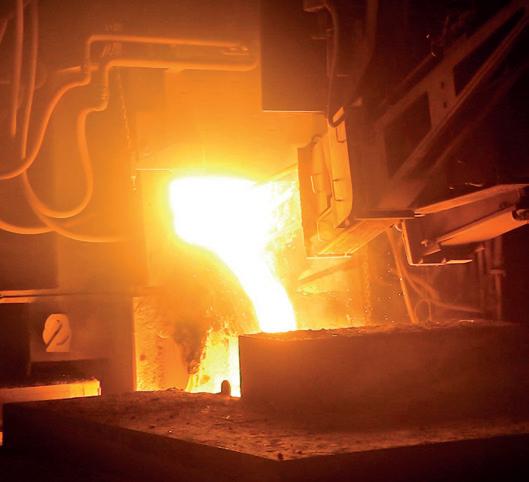
4 NEWS ROUND-UP Digital Edition - August 2023
www.steeltimesint.com
Steelwatch, a new global organisation monitoring carbon emissions from steelmakers, is urging Australian company Bluescope to abandon plans to reline its main blast furnace at Port Kembla in Wollongong. Bluescope's current main blast furnace at Port Kembla is due to reach end-of-life between 2026 and 2030, prompting a billion-dollar investment to replace it. Steelwatch director Caroline Ashley said that if the companies continue investing in emissions-heavy blast furnaces, ‘’We will blow the carbon budget out of the water and we will blow any hopes of stabilising climate change’’.

Source: ABC News, 12 July 2023.
JFE, Japan's second-biggest steelmaker, sees the usage of technology known as 'gigacasting' as a risk to the company's business as it could lead to a reduction of steel demand, its president Koji Kakigi told reporters.
Pioneered by Tesla, gigacasting allows for the production of larger and lighter parts – essential for electric vehicles with heavy batteries – reducing costs, and attracting interest from automobile giants including General Motors and Hyundai Motor. "The amount of crude steel used will obviously decrease," Kakigi told a press conference, calling gigacasting ‘a very big problem’.

Source: Reuters, 12 July 2023.
Teesside International

Airport's business park has reached a new milestone with the first steel now in place at the site. Once operational, Business Park South will comprise 1.9 million sq ft of logistics, distribution and industrial buildings and will create up to 4,400 jobs. More
than 40 tonnes of UK steel is now on-site, sourced from British Steel's Lackenby plant. An extra 42 tonnes of steel is set to be delivered to the site next week to allow all beams to be in place.
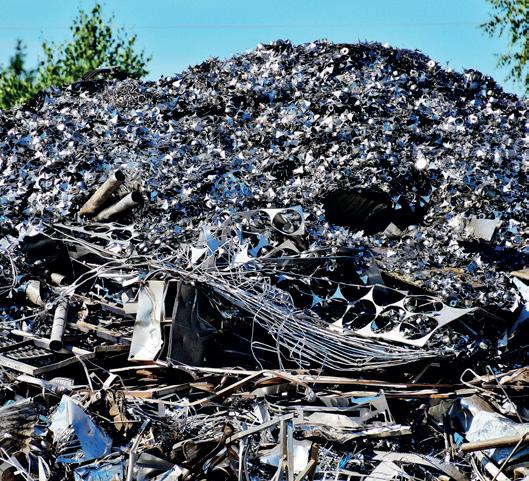
Source: Insider Media, 14 July 2023.
ArcelorMittal Hamburg, a subsidiary of Luxembourgbased steelmaker ArcelorMittal, has announced that it has started using granulate from municipal waste instead of coal to produce crude steel from sponge iron and recycled scrap. The company has been working on developing this process for two years, and now around half of the coal previously used in the electric arc furnace is being replaced by a more resource-saving alternative. With this project, the company is claiming to save 3.5kt/yr of carbon emissions.
Source: Steel Orbis, 13 July 2023.

In a bid to raise awareness on the conservation of snakes, Tata Steel Mining organised a ‘Snakes Are Friends’ campaign at its Chromite Mine campus located in Odisha’s Jajpur district, Eastern India. The programme focused on the practical aspects of snake conservation, including measures to be taken when encountering a snake in the wild or near residential areas. During the interactive session, Subhendu Mallik, general secretary and founder of ‘Snake Helpline’, popularly known as the snake man of Odisha, debunked common myths and misconceptions surrounding snakes while shedding light on their important contribution to the natural environment.

Source: DevDiscourse, 14 July 2023.
ArcelorMittal Europe has launched a new low-carbon steel pipe in line with its decarbonization targets. The new product, made from recycled and renewably manufactured XCarbTM steel has up to 75% less carbon emissions, the company claims, which is one of the lowest carbon rates in the steel tube industry. The company is now able to offer the first low-carbon hollow sections, produced using a high percentage of scrap and 100% renewable electricity.
Source: Steel Orbis, 14 July 2023.
NEWS ROUND-UP 5 Digital Edition - August 2023 www.steeltimesint.com
Buy the Original
Italy, Germany, Sweden, Austria, France, The Netherlands, UK, Spain, Turkey, USA, Brazil, Thailand, India, China, Japan

DAN IELI T R U E GRE EN ME T A L
MIDA–QLP QSP–DUE
in
www.danieli.com
Danieli Headquarters
Buttrio, Udine, Italy
@danieligroup
MIDA–QLP and QSP–DUE are the winning Danieli direct-rolling technologies for the most competitive production of long and flat green-steel products.
They are the result of the research and continuous improvement profused over 20 years, along with multi-million dollars of investment. Their unmatched performances have fueled their success worldwide, thanks to lower resource consumption and carbon emissions, unbeaten OpEx, and outstanding product quality.

So, top technology becomes copied technology, the shortest route for competitors that, abandoning their solutions, now try to imitate MIDA–QLP and QSP–DUE Equipment and layout may be copied, but experts know that details make the difference. Automation and process solutions are not easy to copy, and this will be the experience of anyone trusting in those imitations.
The competitive advantage for our customers, obtained by field results, is the best defense for our technology – more than court rulings protecting our patents.
Danieli offers the best guarantees for speedy learning curves, steady performances, and now Digital Plants with no men on the floor. Buy the Original.
GIANPIETRO BENEDETTI CHAIRMAN OF THE BOARD OF DIRECTORS
Emirates Steel Arkan has signed an agreement with Oman’s leading steel products manufacturer, Al Jazeera Steel Product Company (AJSP), to establish a ‘strategic framework for collaboration’. As part of the agreement, Emirates Steel Arkan said it has the opportunity to supply semis, including billets, blooms and beam blanks to AJSP’s upcoming factory in Abu Dhabi or its existing factory in Sohar, Oman.
Source: Zawya, 14 July 2023.
An executive at UK-based recycling firm, EMR Ltd. says that its membership of a decarbonization consortium has led to experimenting with finding effective scrap blends at a nearby steel mill. In a blog post, EMR cited its involvement in RECTIFI, a
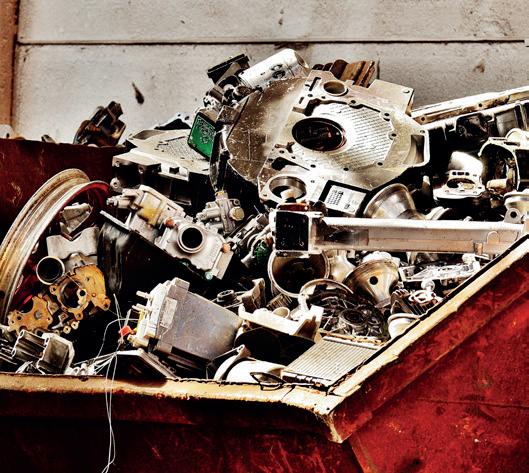
Port of Sines, a major port in Portugal, and Companhia Siderúrgica Nacional (CSN), a leading steel producer in Brazil, have signed a MOU as part of the Global Gateway initiative of the European Commission. The agreement aims to establish the scope, rules, and guiding principles of the joint action to develop sustainable, green, and digital logistics corridors to support a strategy focused on three fundamental pillars: ‘logistics resilience’, ‘energy resilience’, and ‘physical and digital connectivity’.

Source: Offshore Energy, 14 July 2023
project that brings together the steel, cement and recycling industries, as leading to the scrap blend melt shop research. “In preliminary trials with Tata Steel, our teams have demonstrated how new grades of recycled steel can be delivered with the chemistry performance required for high-quality, low-carbon steelmaking, lowering the demand for virgin iron ore,” said Roger Morton, director for technology and innovation at EMR.
Source: Recycling Today, 14 July 2023.
Bathroom manufacturer

An emergency construction programme has succeeded in returning water supplies to the ArcelorMittal Kryvyi Rih steel mill affected by Ukraine’s Kakhovka dam breach. A statement issued


by the steelmaker said the development of the fivekilometre pipeline, along with electricity supplies to two new water pumps, had taken 20 days of ‘around the clock’ work to

complete. Drawing water from the Ingulets River, the pipeline will fill the southern Kakhovka reservoir at a level of about 3,000 cubic metres per hour, it said.
Source: Hellenic Shipping News, 17 July 2023.
Bette has announced it has produced more than 100,000 products using sustainable glazed titanium steel. In 2020, the German-based company changed its glazed titanium steel manufacturing process to one that uses CO2neutral steel. Bette achieved this by working with its steel suppliers and helping them to adopt sustainable manufacturing processes. By using titanium sheets supplied by manufacturers with sustainable credentials, Bette says that its products are CO2neutral.
Source: KBB Review, 17 July 2023.
Siemens Energy is set to invest around €1 billion in Germany as part of its €2 billion investment strategy. The Erlangen campus, which is to be built in the west of Erlangen, will focus on sustainable and future-oriented high-tech manufacturing, related research and development activities, and the opening of the location for an ecosystem of partners from the business and scientific communities. “The leading-edge manufacturing facility being built in Erlangen is a good example of how our economy is moving toward a climate-neutral future – as a strong industrial country with good sustainable jobs,” said German chancellor Olaf Scholz.
Source: Metal AM, 17 July 2023.
8 NEWS ROUND-UP www.steeltimesint.com Digital Edition - August 2023
Mining company BHP, Monash University and Chinese steelmaker Baowu have initiated a new Industry Knowledge Centre, with its initial phase including piloting and plant-scale trials of potential carbon abatement technology for steel production. According to a statement from BHP, it said it would provide $8 million over three years to the initiative, with Baowu contributing in-kind support for the initial phase of work, and the Monash Suzhou Research Institute focusing on administrative duties.
Source: AU Manufacturing, 18 July 2023.
Steel and logistics companies in the UAE and Japan have signed a Memorandum of Understanding (MOU) for establishing a low-carbon iron supply chain following the Japanese prime minister’s visit to the country. The agreement is to collaborate on activities for building a low-carbon iron complex in Abu Dhabi. The complex aims to produce lowcarbon emission raw materials for use in steelmaking as part of a partnership between the countries to co-operate on economy, trade, technology, energy, space, and education.

Source: Supply Management, 18 July 2023.
The owner of Jaguar Land Rover has unveiled plans to build an electric car battery factory in the UK. Tata Group says it's planning to invest more than £4 billion, with British prime minister Rishi Sunak declaring that the new plant in Somerset will create thousands of skilled jobs across the country. The deal is the culmination of months of talks with the government over taxpayer subsidies to fend off reported competition for the investment from Spain. Source: Sky News, 19 July 2023.

ArcelorMittal has started production of low carbon heavy steel plate, up to 18 tonnes in weight, using slab from its Belgian asset and processing these at its heavy plate mill in Asturias, Spain. Slab will be produced at the company’s electric-arc furnace-equipped Industeel mill in Charleroi, Belgium, using feedstock that is almost 100% scrap as well as electricity from 100%

renewable sources. The slabs will then be rolled into heavy plate at ArcelorMittal’s heavy plate mill in Gijon, Spain. Source: Fastmarkets, 20 July 2023.
Ukrainian steelmaker Metinvest has accused the Hungarian government of selling a steel plant to Sanjeev Gupta, chair of mining conglomerate GFG Alliance, for less than a third of its true value. Metinvest, which was excluded from the bidding process for the bankrupt firm ISD Dunaferr Zrt., alleged in a statement that the auction had not been transparent, and called on the European Union to investigate it. The Hungarian government has hailed the deal as ‘saving’ the plant.



Source: Bloomberg, 20 July 2023.
According to media reports, Japanese steelmaker Tokyo Steel Manufacturing will transition to round-the-clock operations at all of its electric-furnace facilities by the end of the decade, with plans to harness solar power and other renewables. Tokyo Steel normally operates mills at night on weekdays and idles them during daytime hours, due to electric arc furnaces consuming an outsized amount of energy and with electricity rates being cheaper at night. However, as the company is located close to multiple solar farms, it has decided to go forward with daytime operations in an attempt to reduce outages.
Source: Nikkei Asia, 23 July 2023.
www.steeltimesint.com NEWS ROUND-UP 9 Digital Edition - August 2023
Australian iron ore producer Fortescue Metals has shipped the first batch of ore from the 22Mt/yr Iron Bridge magnetite project in Western Australia to a customer in Vietnam. The Iron Bridge project is designed to increase the overall grade of Fortescue's products, but it remains unclear if it will remain a standalone product or be included in a blend with the firm's lower-grade direct shipping ores. The company hopes to ship 10Mt of Iron Bridge concentrate in 202324.
Source: Argus Media, 25 July 2023.
ArcelorMittal has announced that it is suspending plans to construct a pellet plant in Kryvyi Rih, Ukraine, until the current war with Russia has concluded, the company announced in its report for the first six months of 2023. "The previously announced strategic capex envelope has now been revised... whilst the Ukraine pellet plant project, previously on hold, is removed," said the report,
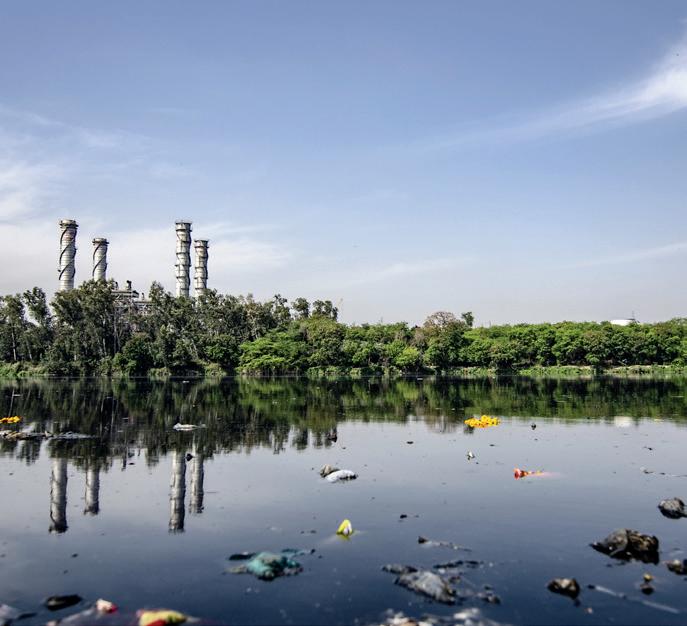
The European Commission (EC) has approved, under EU State aid rules, a €850 million French measure to support ArcelorMittal France in partially decarbonizing its steel production processes. The measure will contribute to the achievement of the EU Hydrogen Strategy, the European Green Deal and the Green Deal Industrial Plan targets, while helping to end dependence on Russian fossil fuels and fast forward the green transition in line with the REPowerEU Plan, according to the EC.

Source: BioEnergy Insights, 25 July 2023.
A spillage of a chemical from a waste facility operated by ArcelorMittal Liberia has polluted water sources in Nimba County, Liberia. The situation, according to the Environmental Protection Agency (EPA), is ‘depriving villagers of their livelihood’ and has resulted in a ‘eutrophic’ condition leading to overgrowth of vegetation. According to the EPA, contaminated sewage from the steel giant was directly discharged into wetlands that border communities in its operational areas. “The sewage discharge resulted in microbial proliferation, causing a corresponding negative impact on surface water quality,” EPA executive director Wilson Tarpeh commented.
Source: Daily Observer, 25 July 2023.
JSW Steel plans to utilise green power from the 3.8kt hydrogen plant being set up at its Vijayanagar plant, which will enable it to supply green steel in 18-24 months. The company has signed a contract with JSW Energy to source green hydrogen and green oxygen. JSW Steel will have nearly 25 MW of roundthe-clock renewable power and will receive carbon credits based on the amount of thermal power being replaced with green energy.
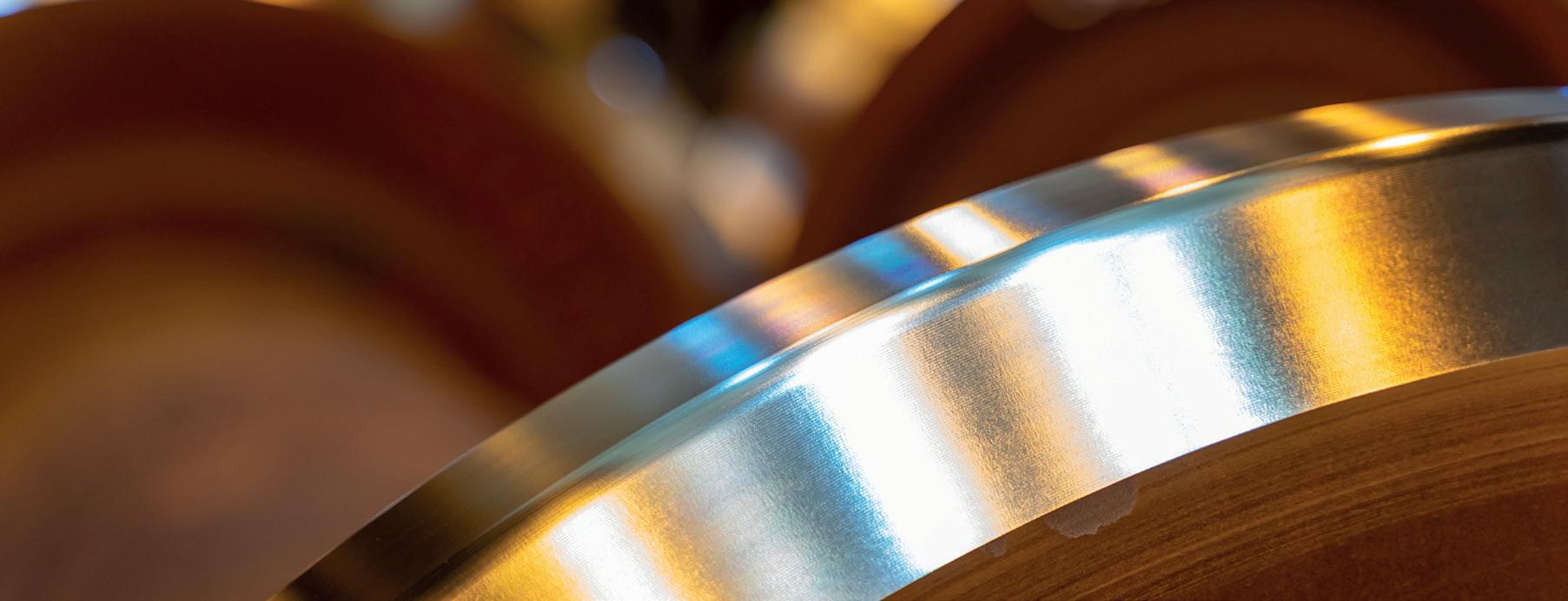

Source: Projects Today, 26 July 2023.
which was published on 27 July.
Source: Yahoo! news, 1 August 2023.
Indian special chief secretary (environment, forest, science and technology) Neerabh
Kumar Prasad urged the country’s steel industry to adopt innovative practices
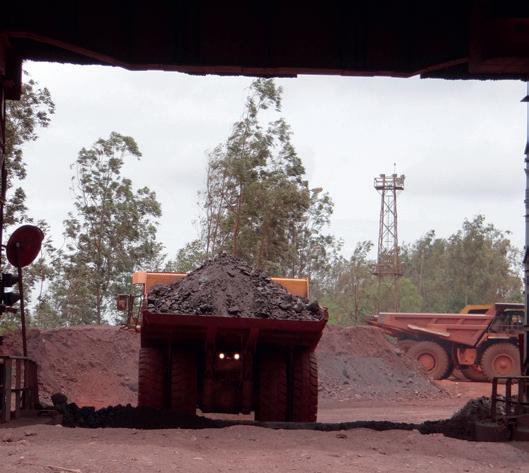
Indian steelmaker JSW Steel plans to spend $666 million to construct a plant for cold-rolled grain-orientated steel (CRGO), in collaboration with JSE Steel, the company announced this month. In a regulatory filing, JSW Steel said the project will be funded through equity contributions from multiple partners, as well as other financial institutions. The plant will be located within JSW Steel’s existing mill in Karnataka, southern India.

Source: Steel Orbis, 3 August 2023.

to reduce environmental footprint and contribute to sustainable development during a steel and alloy conference. Speaking at the event, Prasad emphasized the importance for steelmakers to ‘minimise the environmental impact of the industry’. Prasad also estimated that the country’s annual steel production capacity will increase to 300Mt by 2030, and to 500Mt by 2047.
Source: The Hindu, 2 August 2023.
10 NEWS ROUND-UP
Fives to supply tubular goods solution to Husteel facility in Splendora, Texas
Fives, an international engineering group headquartered in France, has signed a contract with Husteel to design and supply a complete solution to manufacture oil country tubular goods for its new plant in the USA. Husteel, part of South Korea’s Shinan Group, is a welded tube and pipe manufacturer. The company is investing $122 million into a greenfield plant in Splendora, Texas.
Fives will provide engineering, manufacturing and supply of the complete solution to produce tube and pipe with a diameter of 60mm to 114 mm and a wall thickness of up to 10mm for the oil and gas industry.

“The new plant in Texas will be our first facility
in the United States. We are relying on Fives’ presence in the local market, its long-standing reputation as a supplier of reliable equipment, and their vast experience. We look forward to starting production in this new facility in 2025,” commented Hoon Park, CEO of Husteel.
The scope of supply from Fives will include:
• Abbey slitter
• Abbey mill for welded tube and pipe
• Bronx 6-roll straightener
• Taylor-Wilson end facer
• Taylor-Wilson blow out station
• Taylor-Wilson triple-head hydrostatic tester
• Taylor-Wilson dual-head drifter
• Weight measure stencil and coating stations
• Taylor-Wilson packaging system
“We are very proud and excited to be part of this new project delivering our complete solution from slitting to tube finishing. This is our largest fully integrated contract with a renowned manufacturer in our history,” said Jon Dunn, president and chief executive officer of Fives Bronx, Fives subsidiaries in the US and UK.
Both companies specialize in slitters, mills and finishing equipment under historical brands of Abbey, Bronx and Taylor-Wilson.
For further information, log on to www.fives.com
INNOVATIONS www.steeltimesint.com 11
Digital Edition - August 2023
Tenova revamps EAF
ORI Martin, a European integrated steel group which produces steel for the automotive, fastener, mechanical and building sectors, has awarded sustainable solutions provider Tenova a new contract to replace its EAF at its mill in Brescia, Italy. This latest contract continues the decades’ long partnership between the two companies which began in 1998, when ORI Martin commissioned Tenova’s Consteel® EAF, making it the first Consteel® in Europe at the time.
In 2015, after more than 15 years of production, Tenova was contracted to modernize the Consteel® unit, as well as install a heat recovery system on the primary off-gas line exiting the new Consteel® to recover the available thermal energy in the off-gas for the production of steam. The iRecovery® system continues to deliver thermal energy to Brescia’s district heating grid during winter, as well as feeding an ORC turbo-generator to produce electric energy for ORI Martin’s internal use. In 2019, Tenova partnered again with ORI Martin on the Lighthouse
Plant ‘Acciaio_4.0’, a project supported by the Italian Smart Factory Cluster which created a Cyber Physical Factory by integrating Industry 4.0 technologies in the steelmaking process.
Tenova has now been contracted to revamp the 25-year-old EAF, which the company states represents the reliability of its technologies. With this new contract, ORI Martin will finalize the revamping of their plant, optimizing consumption and process for the safe production of steel with minimal environmental impact.

The Brescia plant will also be ready for the installation of an Electro-Magnetic Stirrer with Tenova’s Consteerrer® process which, says Tenova, will increase process efficiency. The Consteerrer® technology is an electro-magnetic stirring system, developed through an exclusive worldwide partnership with ABB. According to Tenova, it offers significantly low operating costs, extremely reliable and safe operations, as well as superior quality steel.
“We are delighted to continue this decades’
long partnership with ORI Martin, which is a true testament to the reliability of Tenova’s technologies and a great manifestation of ORI Martin’s trust in our company,” said Mario Marcozzi, Tenova’s upstream sales and marketing director.
“Sustainability has always been a core value at ORI Martin, as we have pursued strategies to protect the environment and facilitate a circular economy. As early as 1998, we were investing in technologies to mitigate our impact on the environment, which is how we came to Tenova, who has been a trusted and reliable partner throughout. With this latest generation Consteel® EAF, we are confident ORI Martin will continue to be one of the most flexible, efficient and environmentally friendly steel meltshops,” said Natale Gaudenzi, ORI Martin plant manager.
Start-up of the new furnace is scheduled for June 2024.
For further information, log on to www.tenova.com
INNOVATIONS 12 www.steeltimesint.com Digital Edition - August 2023
#itsmorethanjustamachine
UNIQUE
3-ROLL TECHNOLOGY FOR SBQ SIZING. A Reducing & Sizing Block for long products keeping its promises. Achieve your goals with KOCKS RSB®.


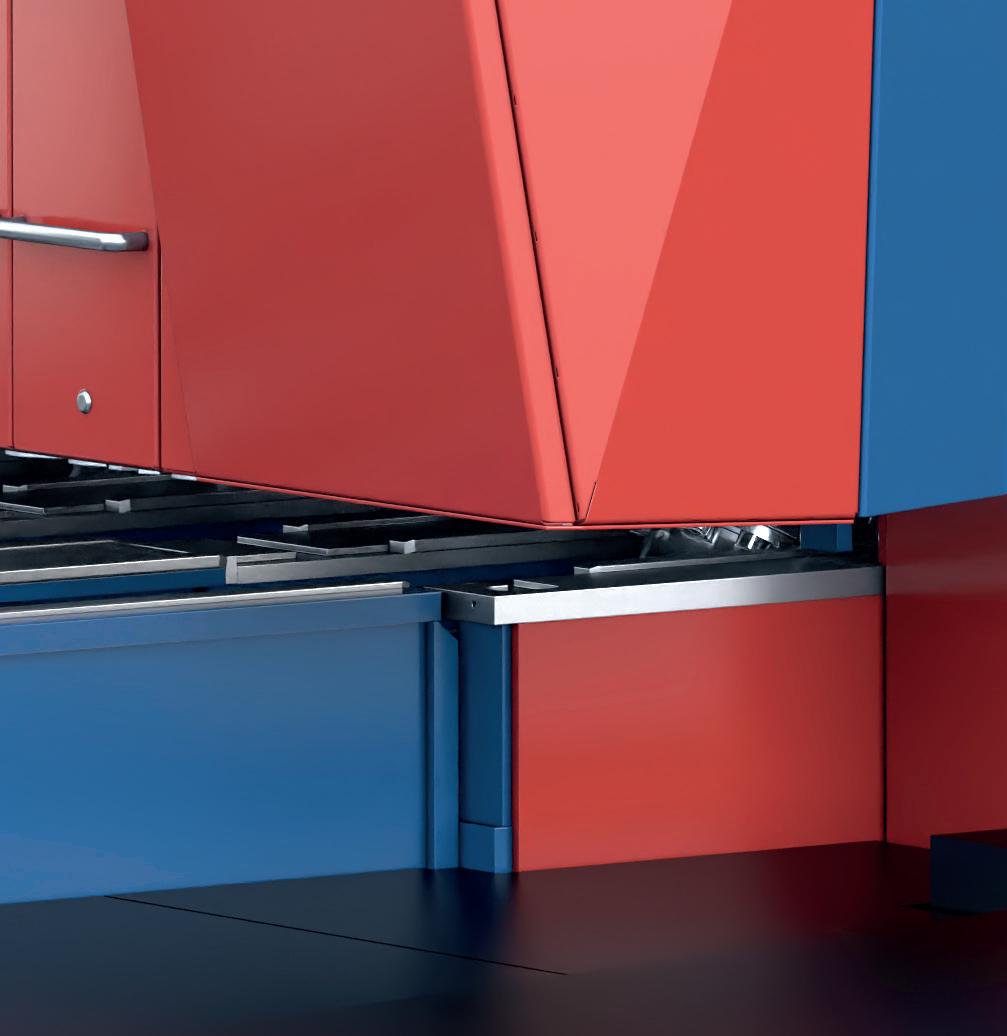
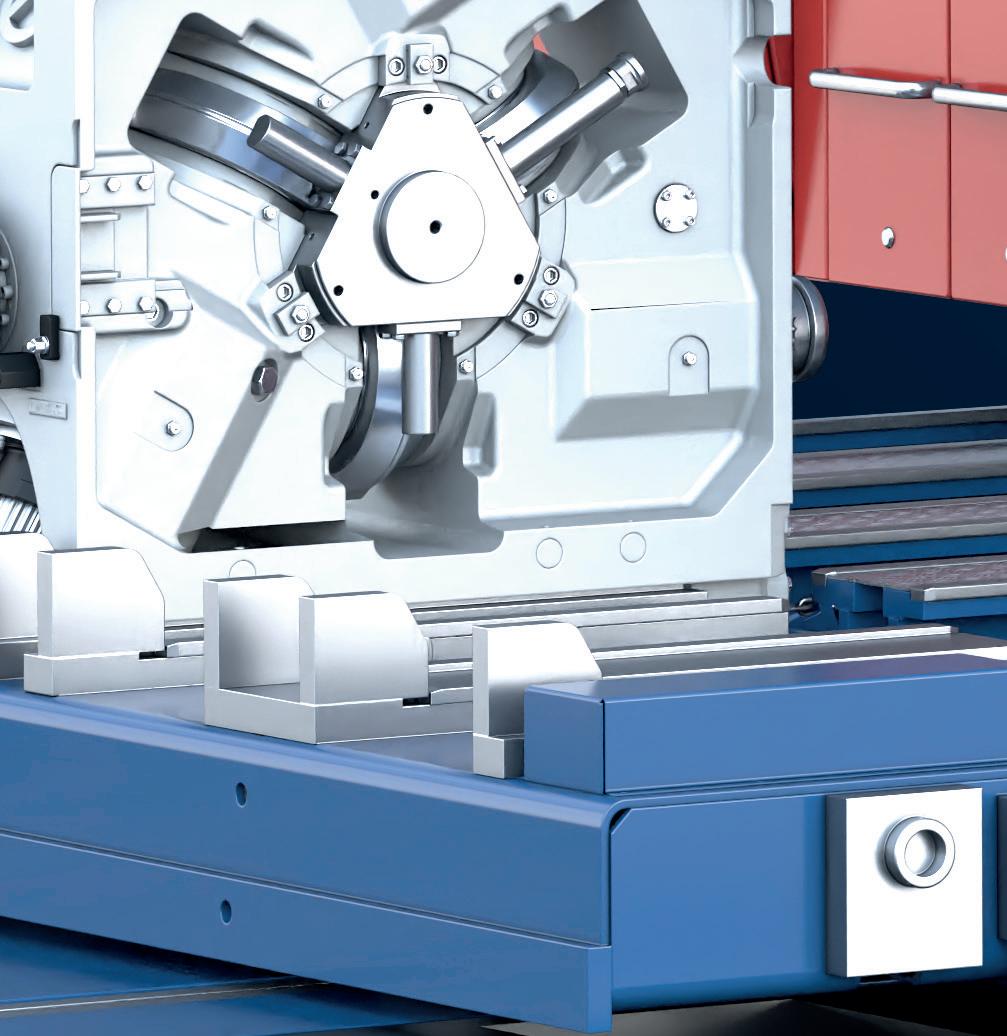
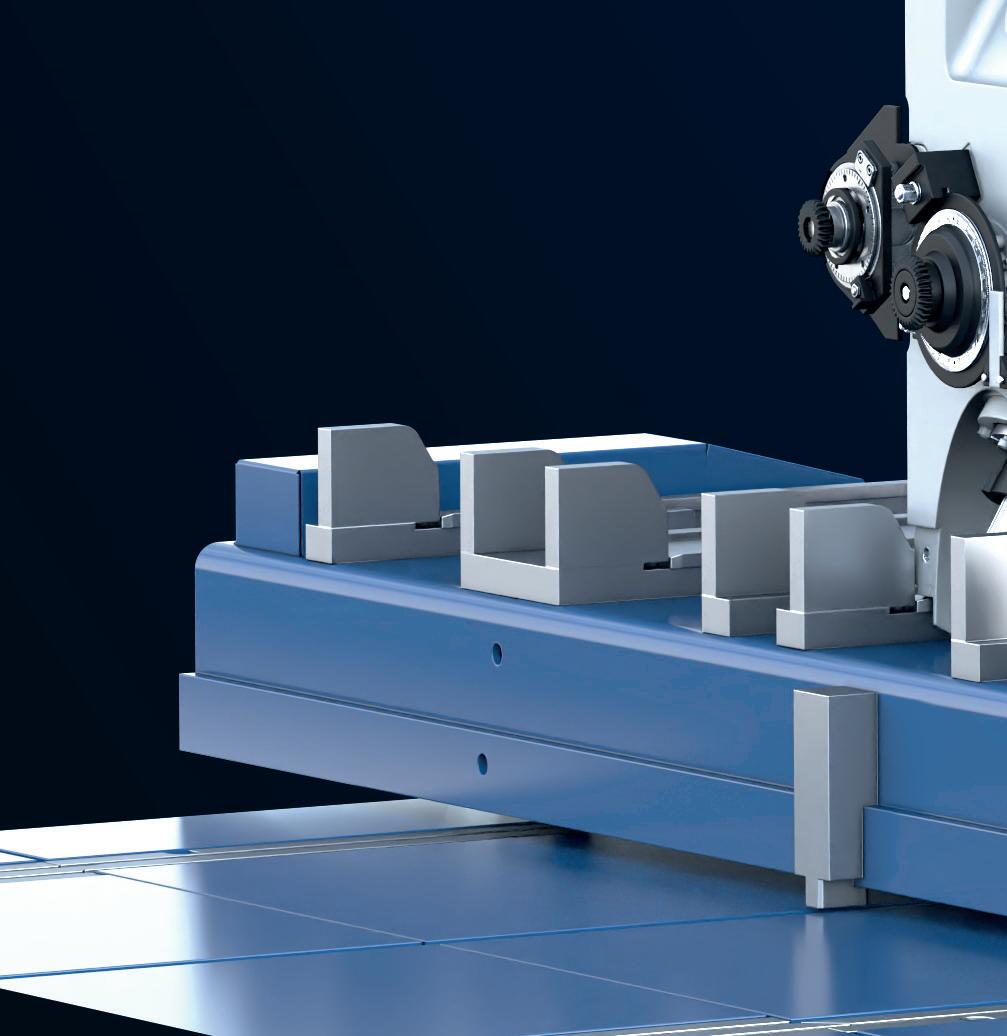





up to 160mm
finishing size in round or hexagonal dimensions

up to 20%



increase in production
up to 10% energy savings in the mill line



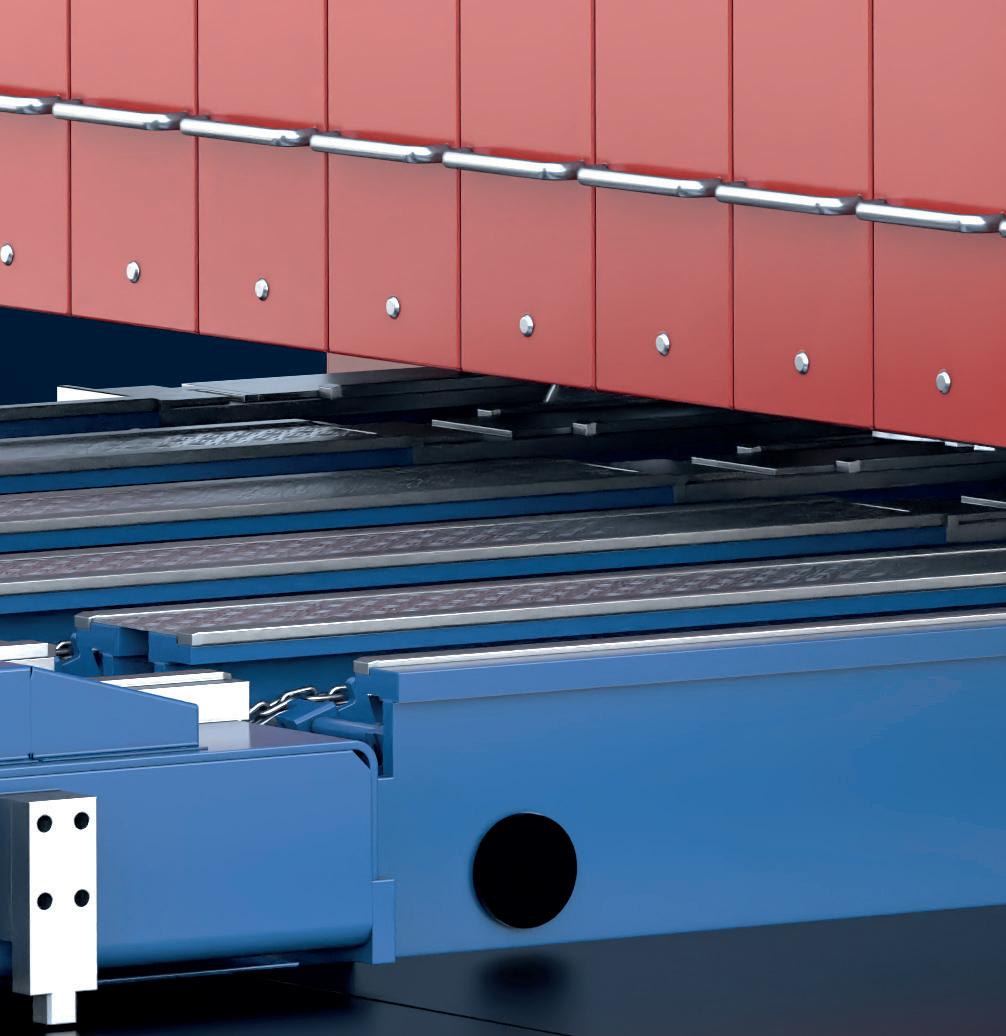









WE MAKE YOUR PRODUCT GOLD www.kocks.de
FUTURE STEEL FORUM
2023
DIGITALIZATION AND



The Future Steel Forum, now in its SEVENTH successful year, is heading for Vienna this September to examine the important relationship between digital manufacturing and the decarbonization of the steelmaking process. Come and listen to experts from the two most important areas of global steelmaking at present. This is a must-attend conference



SPEAKERS FOR FUTURE STEEL FORUM IN VIENNA INCLUDE:

www.FutureSteelForum.com @Future_Steel Follow our LinkedIn Page
Anna Domènech, CELSA Group
Kurt Herzog Primetals Technologies
Michael Eder voestalpine
Pankaj Kumar Tata Steel Ltd, India










20-21 SEPTEMBER 2023 HILTON VIENNA PARK | AUSTRIA DECARBONIZATION SPONSOR OR EXHIBIT To discuss any sponsorship opportunities or exhibition enquires, please contact Paul Rossage now on paulrossage@quartzltd.com Sponsored by O cial Media Partner Since 1866 Organised by SCAN HERE TO REGISTER
Stanislav Zinchenko GMK Center
Dr. Roman Stiftner Austrian Mining & Steel Association
Carlos Russell Ternium
for anybody with an interest in the fast-developing world of Industry 4.0 technologies and those responsible for sustainable steel manufacturing.
Dr. Klaus Peters ESTEP
New order for KOCKS RSB® from China

The Chinese steel producer Xingtai Iron & Steel Co. Ltd. and Friedrich KOCKS GmbH & Co. KG have signed a contract for the installation of an RSB® 370++/4 Reducing & Sizing Block in 5.0 design, which is considered the centerpiece of the company’s new rolling mill complex for the production of special steels. This new order from Xingtai is in line with its plans to relocate production to the Chengdong Industrial Area, which is located in Wei County in Hebei Province
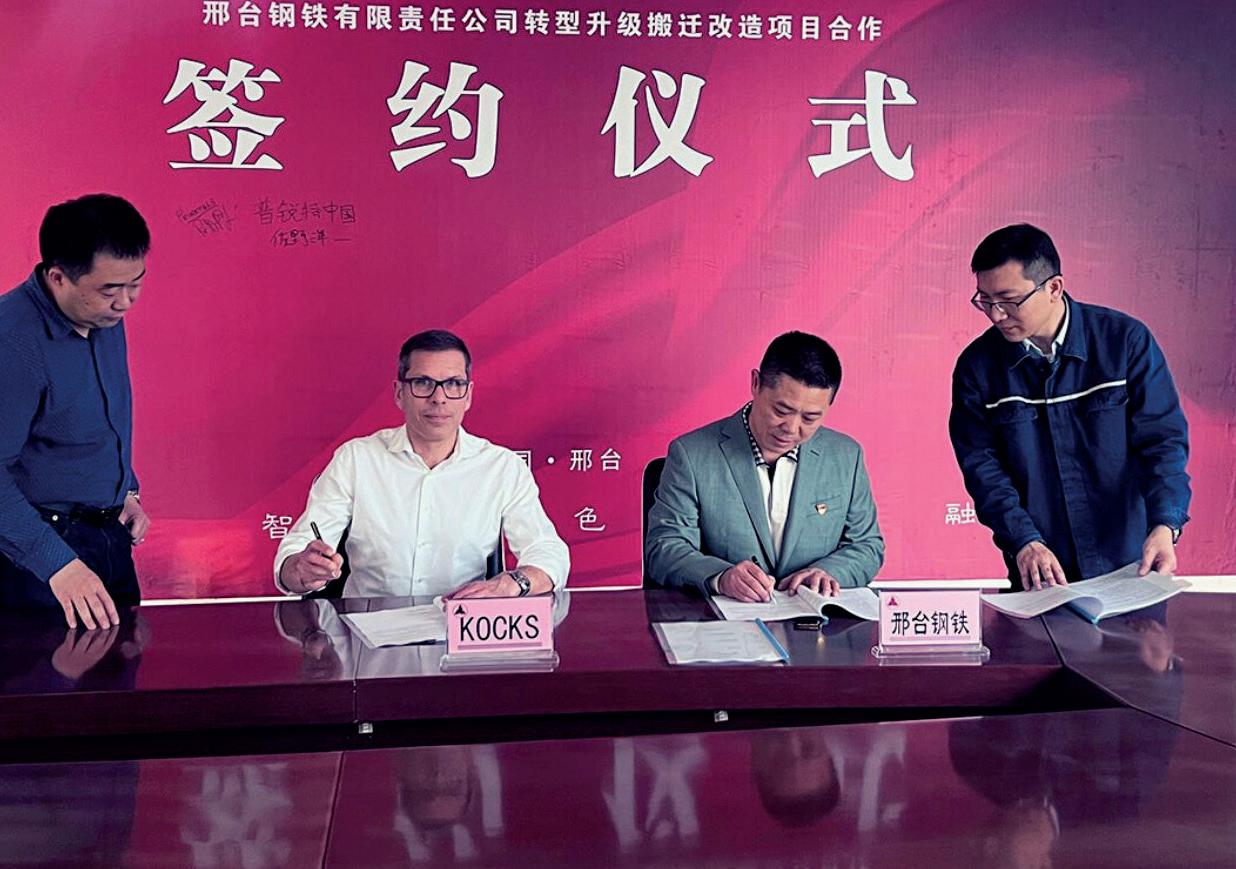
With an annual output of 3Mt, Xingtai Iron & Steel is known for its production of specialty steels. The steel producer is also the first steel company in China to manufacture bar in coil (BIC). In the new rolling mill of Xingtai Iron & Steel Co. Ltd., the KOCKS 3-roll RSB® 370++/4 will be located as the finishing block after 18 stands in H/V arrangement in a 900.000 t/a SBQ mill. It will produce BIC within a finished size range of Ø 16.00 to 52.00 mm with the highest
Thermo Fisher Scientific releases optical emission spectrometer
Thermo Fisher Scientific has announced the latest iteration to its range of ARL iSpark Series Optical Emission Spectrometers. The Thermo Scientific™ ARL iSpark™ 8860 Inclusion Analyzer with Spark-DAT includes all the features necessary for both thorough elemental analysis of steel and ultra-fast inclusion analysis, states the company. The spectrometer aims to keep the lowest inclusion content of steel products at the point of manufacture to prevent costly production issues, like nozzle clogging during continuous casting processes.
According to Thermo Fisher Scientific, the ARL iSpark 8860 Inclusion Analyzer is the first optical emission spectrometer on the market to combine full elemental coverage with rapid characterization of non-metallic inclusions in a single analysis. It can identify and determine features such as the type, number, size, concentration and volume fraction of inclusions, allowing steel manufactur-

ers to control inclusion content in steel products in real time. In turn, this can help to prevent costly process issues and the detrimental effects of inclusions on the mechanical properties of end products, ensuring high quality steel production and minimizing the risk of customer claims or product returns.
Features include:
• Part of the ARL iSpark Series – the trusted standard in optical emission spectroscopy
• Fully equipped to generate advanced elemental concentrations and inclusion data in steel

• 1m vacuum Paschen-Runge optics with photomultiplier tube (PMT) detectors
• Full elemental coverage, including gas elements
• Fast inclusion analysis
• Comprehensive inclusion analysis software tools, including Spark Explorer, Inclusions Report and Statistical Process Control (SPC)
dimensional tolerance, it is claimed. The scope of supply also includes the remote control for stand and guide adjustments, the equipment for the roll shop, and KOCKS software solutions for optimum rolling results. The commissioning of the RSB® is scheduled for the end of 2024.
For further information, log on to www.kocks.de
• Inclusion analysis method customization and training with
Thermo Fisher Scientific experts
• Automated with the ARL Sample Manipulation System (SMS)
For further information, log on to www.thermofisher.com
16 www.steeltimesint.com Digital Edition - August 2023
ABB launches new generation of NEMA motor
ABB has developed the new generation AMI 5800 NEMA modular induction motor to offer energy efficiency and reliability in demanding applications such as pumps, compressors, fans, extruders, conveyors and crushers. Rated for a power output of up to 1750 HP, the AMI 5800 offers the capability for a high degree of modularity and customization to suit both new build and upgrade projects in a wide range of industries including chemical oil and gas, conventional power generation, mining and cement and metals.
The AMI 5800 motor is a true NEMA design that aims to meet both electrical performance requirements and mechanical mounting standards.
Manufacturing company Resonac Corporation has decided to acquire 100% of outstanding shares in AMI Automation. Resonac acquired 50% ownership in AMI on 5 February 2021 with an option to acquire the remaining 50% of shares within five years from that date. Resonac will acquire the remaining 50% to complete the acquisition of 100% shares in AMI by the third quarter of 2023.
AMI is a global provider of automation solutions, including hardware, software, and services for a wide range of industries. AMI provides software and services to optimize the operation

A key feature is a high-strength welded steel frame typically found only in motors with larger frame sizes. This, says ABB, lowers stress on the motor while mitigating vibrations and resonance to ensure reliable operation in harsh conditions with a design life of 25 years or 20,000 starts.
A further important advantage of the AMI 5800 is a shorter bearing-to-bearing span compared with previous models. This innovative feature improves performance at high speeds and enables the motor to be used as a simple drop-in replacement to upgrade existing equipment.
Sam Patrick, ABB product manager large motors and generators, said: “We have engineered the AMI 5800 motor to meet customer requirements for high energy efficiency and reliability as well as sustainable manufacture and use. Its modular design in terms of cooling methods, bearings, shaft extensions and terminal boxes also provides the flexibility to match the North American installed base. That makes the
AMI 5800 ideally suited for both upgrading existing installations and next generation designs no matter how harsh the environment it will be operating in.”
The majority of regular AMI 5800 designs not only meet but exceed North American standards for energy efficiency. Further customization will allow some models to operate above the IE4 equivalent level of energy efficiency while meeting NEMA electrical performance standards.
The new motor is configured for optimal airflow, meaning that it is designed to run as cool as possible, whether in an open-air installation or completely enclosed with a cooler. According to ABB, the time-tested MICADUR® insulation system makes the motor suitable for starting high inertia loads direct online (DOL) while it is also an ideal partner for variable speed drives (VSDs).
For further information, log on to www.abb.com
of EAFs, which are used by the steel industry. In North America, where the EAF market is expected to expand further, about 90% of EAF steel is produced using AMI’s software. Resonac is a global provider of graphite electrodes, with the world’s largest graphite electrode production capacity in six manufacturing facilities strategically located around the world.

The acquisition of 100% of AMI shares will allow Resonac to make its graphite business evolve from simple provision of electrode products into provision of total solution services for EAF including support to digitalization of the pro-
duction process, according to a company press announcement.
Resonac plans to invest heavily in new product development for the current metals, paper, mining, and cement markets, and expects to leverage this expertise in automation and control software, hardware, and power systems to accelerate digital transformation in areas such as Condition Based Maintenance (CBM) and predictive analytics.
For further information, log on to www.amiautomation.com

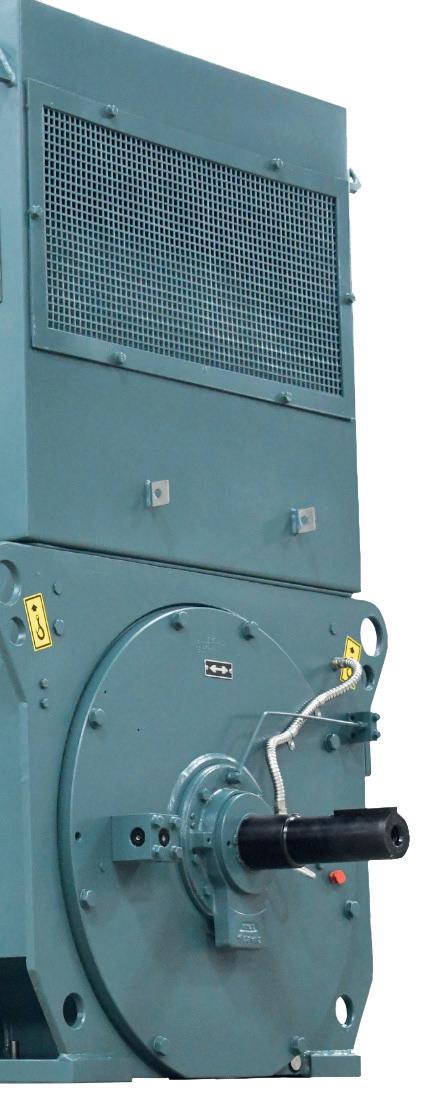
17 INNOVATIONS
Resonac to acquire 100% of shares in AMI Automation
Siemens supplies ‘motion picture’ at steel mill
A major US steel mill in Arkansas required an entirely new approach to coil handling for its rolledto-order production strategy. Its engineering and materials handling equipment partner, Morgan Automation, devised and implemented a fully automated, non-manned series of three cranes to work with two coil transfer cars accepting hot coils off the walking beam from the hot mill. In manufacturing this system solution, Morgan turned to its long-time drives and motion control partner, Siemens, who provided a full complement of drive, plc, safety I/O, power quality meters, PCs, wireless hardware plus communication software and its TIA Portal for commissioning and monitoring on the project. According to the president of Morgan Automation, Mark Sharamitaro, “The excellent reliability and performance of the Siemens solution on this project was invaluable in helping us achieve complete operational efficiency and zero downtime during the first six months of operation.”

This greenfield project involved the handling of approximately 1,000 coils or 30kt of steel a day at the mill. A typical coil in this yard is approximately 83” OD x 82” W and weighs 28 tons on average. As the mill operates on a ‘made
to order’ mindset, there is a dual challenge of handling hot coils from the mill and organizing their staging for shipment by truck, rail or barge, with an additional quadrant on the ground for coils heading via the coil transfer cars provided by Morgan to the Pickling Line Tandem Cold Mill (PLTCM) on the premises. In the proposed and enclosed coil yard, the walking beam would deliver the coils from the hot mill, then the crane grab would secure the individual coil and place it in the coil transfer car or on a saddle in the appropriate quadrant on the floor. During low production times, the system would defrag the coil assortment into the proper positions to conserve storage space with full tracking in real time. Each crane has a thermal imaging camera for temperature sensing plus a patent-pending laser positioning system. The comprehensive data tracking is clearly displayed in the mill control room with real time KPI calculations.
The goals for this new autonomous coil yard (ACY) included the indoor facility to reduce rust and corrosion, improved coil handling to meet the shipping protocols, reduced energy costs by eliminating lift truck handling and reducing physical distancing of coils, plus faster location of
the coils on their saddles for crane handling into shipment staging areas. Critical overall was the safety of the personnel, so a system of nine remote I/O cabinets and 21 safety gates was to be implemented. Integration of the entire operation was to be handled by the proprietary Morgan CEPHAS logistic management system with a rules-based engine for algorithmic decision-making. All the information management would be transmitted and handled by mill personnel, using the in-house platform and virtual private network (VPN).
With those logistics, performance goals and system integration requirements, Morgan began the process of working with the Siemens team to utilize the full range of product and software options for construction of the optimum materials handling, motion control and data management system for the ACY. According to Mark Sharamitaro, “We were bringing our established CEPHAS warehouse management system to this challenge and seeking to marry it to a single user interface, driven by the rules established by our customer, so there’s essentially a single bucket of data on each coil.” In that ‘bucket’ are all the physical characteristics and temperature of the
INNOVATIONS SPECIAL www.steeltimesint.com 18
Digital Edition - August 2023
coil plus the determined location for placement. All this data is transmitted through a series of Siemens SINAMICS drive modules, SIMATIC PLCs and the SINEMA network monitoring server, complemented by WinCC V16 supervisory control for monitoring over long distances. In addition, Siemens offered its SCALANCE wireless suite of ethernet switches and access points to communicate the ring topology and VLAN data to the mill control room personnel.
Sharamitaro noted the need for an embedded quality system to identify secondary coils on the floor and determine their transfer path. As each coil is grabbed, a full battery of sensors, switches, I/O power supply, drives, PLCs and wireless communication sends information from the crane trolley directly to the control house. The three 190-ton cranes are thus fully synchronized for handling the incoming coils from the hot mill plus the placement of the coils in the transfer cars and staging lines. The information feeds the CEPHAS system of Morgan Automation, which makes the algorithmic determinations for each coil, based on predetermined parameters set by the mill. An efficient and reliable system of coil handling is achieved, as a result.
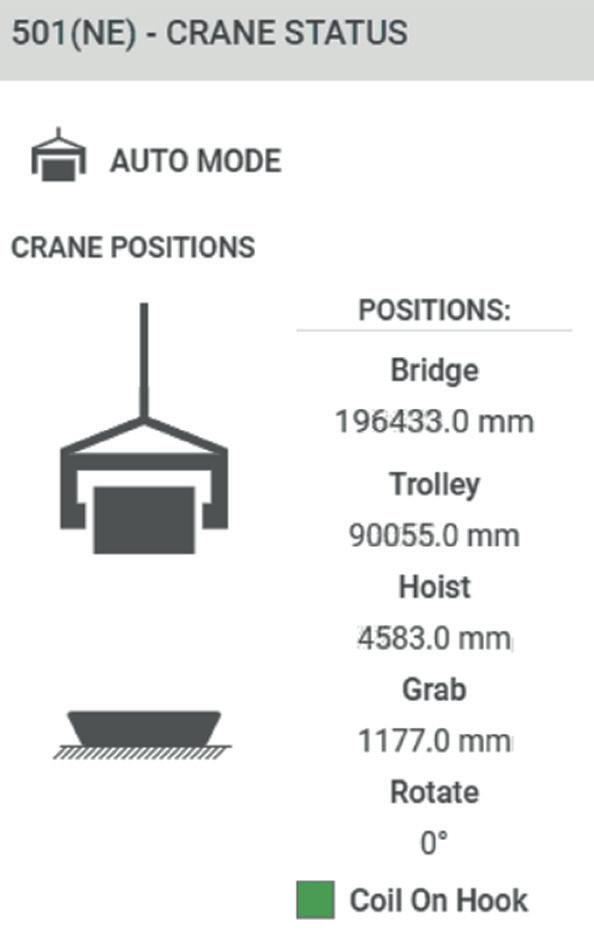

To evidence the energy savings, Siemens also provided its PAC3200 power meters that track and record power consumption ongoing in a system and efficiently communicate data over a network protocol. Another key component in the Siemens solution was the SINAMICS S120 Smart Line Module for crane applications, which features onboard regenerative drive. This feature takes the excess motor power from a crane hoist, for example, during descent, and feeds it to another component in the system or back to the grid for trackable energy savings to the customer. Furthermore, this Smart Line Module has particular application in the crane world, as it features a line-commutated infeed that is enhanced by the use of insulated gate bipolar transistors that avoid commutation faults typical of thyristor-based rectifiers.
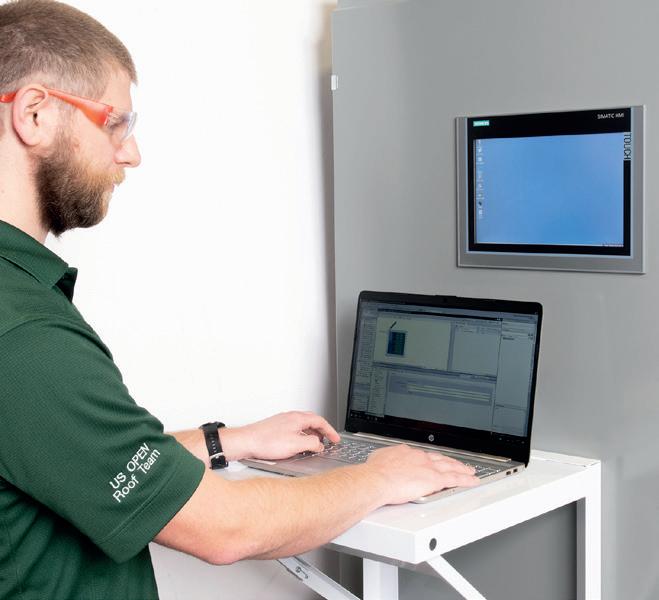


For further information, log on to www.siemens.com
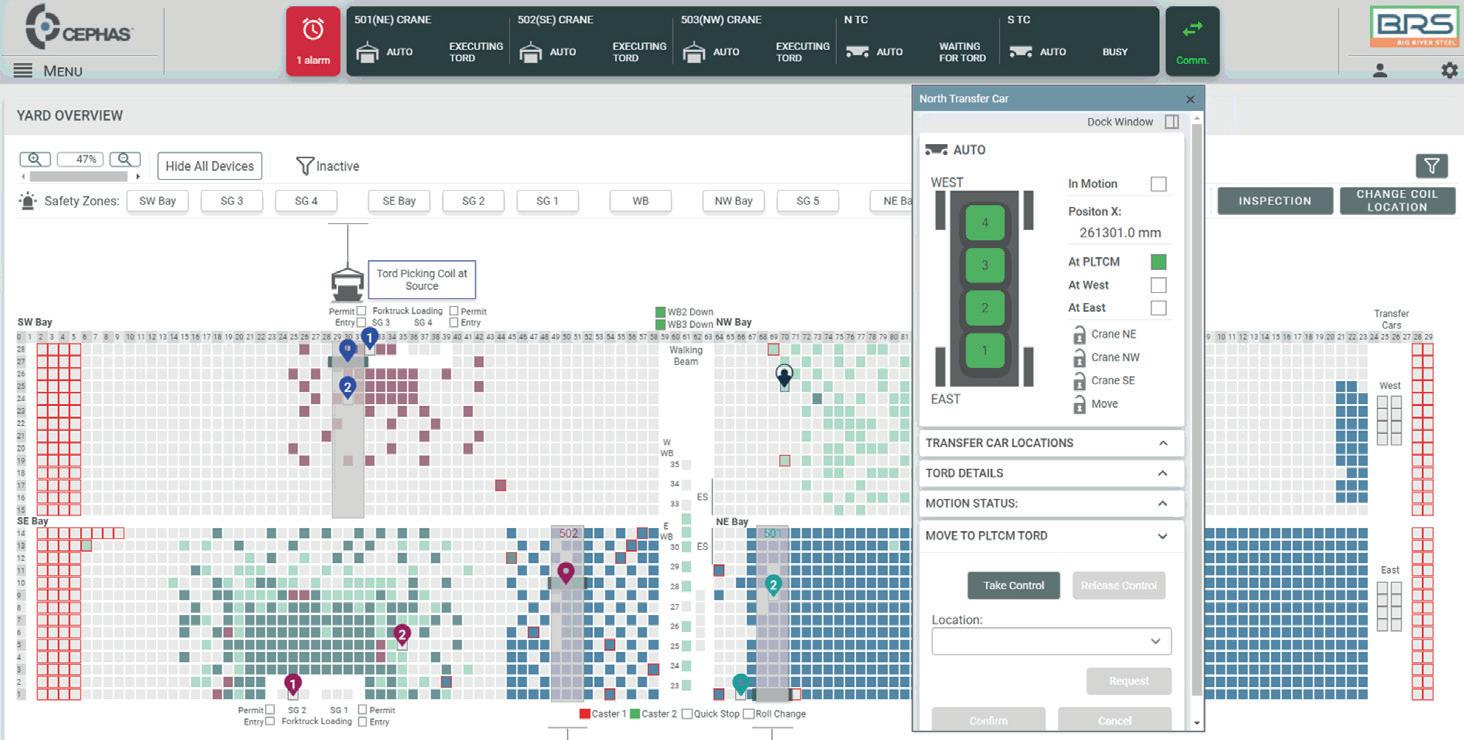
INNOVATIONS 19
A. Typical control cabinet houses drives and other hardware to run the crane system.
B. Morgan technician programmes the Siemens PLC to co-ordinate with the Morgan CEPHAS system for ACY control.
C. CEPHAS logistic management system tracks every coil being handled.
D. CEPHAS system provided by Morgan tracks the position and status of every coil in the ACY, divided by grid location for staging of shipments.
E. PLC unit controls the drives to position the crane for handling of each coil from the mill and position the coil in the proper staging area of the ACY.
A B C D E
Autonomous Coil Yard (ACY) run at major steel company in the Midwest, operated by crane system provided to the mill by Morgan Automation of Alliance, Ohio. Myriad Siemens controls are onboard the system, both hardware and software.
DIGITALIZATION AND DECARBONIZATION












The Future Steel Forum, now in its SEVENTH successful year, is heading for Vienna this September to examine the important relationship between digital manufacturing and the decarbonization of the steelmaking process. Come and listen to experts from the two most important areas of global steelmaking at present. This is a must-attend conference for anybody with an interest in the fast-developing world of Industry 4.0 technologies and those responsible for sustainable steel manufacturing.
SPONSOR OR EXHIBIT
To discuss any sponsorship opportunities or exhibition enquires, please contact Paul Rossage now on paulrossage@quartzltd.com
FUTURE
2023
STEEL FORUM
@Future_Steel Join our Future Steel Forum Group
SEPTEMBER 2023
VIENNA PARK | AUSTRIA FSF-23-Half-Page-Vertical-Ad-Print.indd 1 02/08/2023 15:49
www.FutureSteelForum.com
20-21
HILTON
Trading: a case of fair or free
FROM its past calls for free trade, when US industry needed to penetrate foreign markets riddled with bureaucratic red tape, high import duties and other obstacles that impeded American exports, the US industry is today increasingly talking about fair trade to curb the inflow of heavily subsidized products that are produced in excess by the regimented economies of the supplying countries.
The term ‘fair trade’ is applied today to China which exploited the free trade concept and recklessly exported what many American steel executives and workers describe as ‘huge quantities of excessive and dirty steel’ that is produced with heavy government subsidies and with high C02 emissions. Many steel executives and the United Steelworkers (USW) had urged lawmakers to stop the rising imports of subsidized steel from China, which had been exporting record quantities of excess steel to provide jobs to its workers and prevent social unrest.
The Trump administration imposed tariffs of 25% and 14% against imports of steel and aluminium respectively under Section 232 of the Trade Expansion Act of 1962 after determination by the Department of Commerce that certain imports threaten to impair US national security.
The much-discussed issue of unfair
trade and its threat to American steel jobs was raised by steel industry executives representing Cleveland-Cliffs, US Steel, Nucor Corp., etc., along with the USW, during a recent hearing of the Congressional Steel Caucus (CSC) in Washington DC, with both labour and steel industry representatives urging the CSC not to let down its guard in view of continuing unfair trade. Steel leaders say that the American steel industry is coming off two strong years but global overcapacity continues to pose a threat, and warn that steel dumping posed a threat to mills and high-paying union steelworker jobs. Both the steel executives and the USW want the enforcement measures to be retained, to maintain a robust domestic industry.
Section 232 trade action, they argued, had helped stabilize the industry, creating thousands of new steel jobs across the country and leading to major investments in new and existing steel plants. Indeed, American steel manufacturers were taking the lead in reducing carbon emissions, with Cleveland-Cliffs investing $1 billion to build a direct reduction plant that has helped the company reduce scope 1 and scope 2 greenhouse gas emissions by 32%, Cleveland-Cliffs president and CEO Lourenco Goncalves testified. Likewise, US Steel has publicly announced that it would
*US correspondent, Steel Times International
work towards its goal of achieving net zero carbon emissions by 2050.
But the problem of global steel excess capacity remains largely unresolved. While many countries are contributing to the problem, US steel producers and steelworkers allege that China continues to be the worst offender. A 2021 report from the Economic Policy Institute found that China ‘used subsidies and other forms of distortionary government support to expand steel capacity by 418%, or 930Mt since 2000, such that by 2019 it controlled just shy of half of global steel capacity.’
The US industry is also alarmed at China’s attempts to circumvent US trade laws by investing in steel production in a number of third countries. USW legislative director Roy Houseman testified that China will add ‘nearly 100Mt of steel capacity in Southeast Asia alone if all planned investments in the region go forward’. There is considerable unease among US steel producers that this excess capacity will find its way into the US market through third countries where China has set up operations.
Houseman said American steelworkers needed a level playing field, a continuation of tariffs, an update of trade laws and ‘Build America, Buy America’ requirements.
“The continued growth of excess steel production capacity demands the

21 www.steeltimesint.com Digital Edition - August 2023
Amid continuing fears of excessive global steel supply being dumped into the US market, the American steel industry has called for legislation to prevent rising imports of ‘dirty steel’.
USA UPDATE
By Manik Mehta*
continued defense of a domestic industry vital to our national security. According to the OECD, over 630Mt of excess steel capacity exists today, with another 166Mt of new steelmaking capacity coming online primarily in the Middle East and South East Asia,” he said. “China accounts for roughly half of the world’s steel capacity output, and the country’s Belt and Road Initiative includes investing in greenhouse gas intensive steelmaking in multiple countries.”
The retention of Section 232 tariffs is being drummed up by steel executives, joined by the steelworkers, who also call for implementation of new trade tools like those found in the ‘Levelling the Playing Field 2.0’ initiative launched recently, Houseman testified.
This initiative aims to modernize the trade remedy tools America needs to counter the unfair economic practices of China and other nations, according to the Alliance for American Manufacturing whose President Scott Paul criticized China: “The Chinese Communist Party has flooded the global market with dumped and subsidized steel and other products for decades. This trade cheating has had very real consequences for communities around America, eliminating millions of family-supporting jobs. In addition to the economic havoc wreaked by China’s cheating, these practices have also threatened to compromise our national security.” He described steel as an essential component of much of America’s infrastructure and defense supply chain.
“Without a stable domestic steel sector, America endangers its ability to quickly respond to the needs of war and grants our foreign adversaries access to our most sensitive systems, including infrastructure.”
The Inflation Reduction Act, the CHIPS and Science Act, and the Bipartisan Infrastructure Law had helped “spark an American manufacturing renaissance”.

The USW union underscored the fact that the Infrastructure Investment and Jobs Act contained ‘Build America, Buy America’ provisions that strengthened the Buy America laws for all federal assistance infrastructure spending. The USW also noted that many agencies and departments had been slow to implement these provisions.

The infrastructure bill itself, along with the existing Buy America policies, the trade union argued, had led to increased work and added jobs at USW represented iron foundries, like at a fire hydrant manufacturer in Albertville, Alabama where USW Local 65B represents over 450 workers. To build on this, the CSC was urged to encourage agencies to speedily implement ‘Build America, Buy America’ by moving from the use of blanket waivers to narrow, transparent waivers.
US Steel senior vice president and chief strategy and sustainability officer Rich Fruehauf, addressing the CSC, cited examples of his company’s investments such as the $60 million invested in a new pig caster at Gary Works. However, he administered caution on the risks to the American steel industry from a recent surge in imports from Mexico.
“Global steel overcapacity, and the actions of foreign governments and producers that feed overcapacity, are a very real threat. This excess steelmaking in China and other countries distorts global steel trade flows,” he said. “Strong trade enforcement and continuation of the
Section 232 national security action on steel imports is critical. “
Nucor Corp’s chairman, president and CEO Leon Topalian told the CSC that his company had experienced robust demand for its products across a range of enduse markets, but he called for vigilance to protect investments in American manufacturing.
“Since the beginning of 2020, Nucor is now more than two-thirds of the way through a $14 billion CAPEX plan that is going to double our earnings potential from our pre-pandemic levels. We recently started up a new state-of-the-art plate mill in Kentucky, and we have announced the addition of new steel mills in West Virginia and North Carolina. We have also added new capabilities at several of our existing steel mills that position us to meet the demand for steel that will be generated by public and private investments in infrastructure, clean energy, and advanced manufacturing facilities producing semiconductors, pharmaceuticals and EV batteries,” he said.
Steel executives representing a cross section of the supply chain gathered in Washington late June for the annual members’ conference of the Steel Manufacturers Association (SMA) and the Metals Service Centre Institute. The conference, called Building the World Together, featured high-profiled speakers who addressed issues of leadership, trade, environmental protection, geopolitics, and policymaking in Washington. The US trade representative, ambassador Katherine Tai, had what some analysts called an ‘informative exchange of views’ with the SMA president Philip K. Bell. �
www.steeltimesint.com Digital Edition - August 2023 USA UPDATE 22
Offshore wind energy: Brazil’s new player?
In a previous article, we investigated how Latin American steel companies are investing in wind energy to clean the energy matrix (Steel Times International, June digital issue 2023, p. 25-26). Now, we must analyse how wind energy can generate additional demand for steel products, with a focus on the Brazilian market. By Germano Mendes de Paula*
2030-2050 (GW)
CURRENTLY, Brazil has 24.14 GW installed capacity of wind energy, distributed among 869 wind farms, which are located in 12 states. There are currently 9,770 wind turbines in operation. Moreover, it is estimated that one additional MW of wind energy capacity requires more than 100kt of steel. Up to now, all wind energy generation in the country has been based on onshore wind farms. Indeed, the absence of a regulatory framework for the production of offshore wind energy blocks such development. Big players are getting ready to invest in such activity, but they need well-defined regulations.
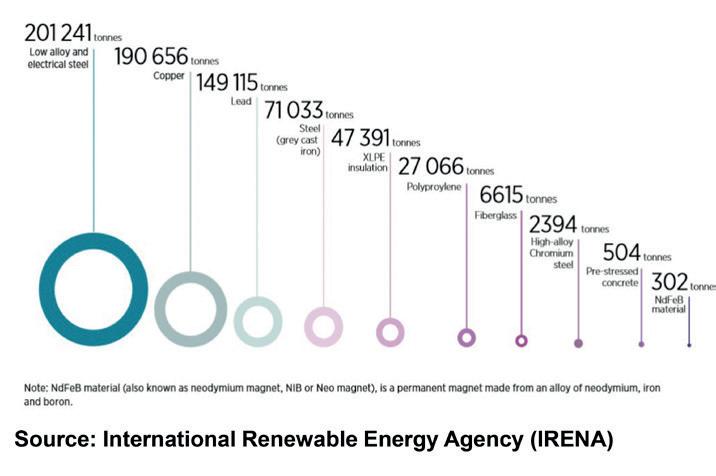
Brazil’s perspectives of offshore wind energy
The Brazilian Wind Energy Association (ABEEólica) has asked the Institute for Graduate Studies and Research in Engineering at the Federal University of Rio de Janeiro (Coppe/UFRJ) and the consultancy firm Essenz Soluções to conduct a huge study, aiming to quantify


the economic impacts of offshore wind energy in Brazil. The report consists of eleven technical notes, co-ordinated by Maurício Tolmasquim. One of the notes focused on demand and supply of components and materials, including steel, and was written by Eliab Ricarte and Bruna Guimarães. The following paragraphs summarise the 65-page document.

To ensure an accurate representation of
an offshore wind energy project, the study was divided into the following components: a) wind turbines; b) monopile foundations; c) monopile transition parts; d) jacket bases; e) gravity-based foundations; f) floating semi-submersible platforms; g) mooring systems; h) cables; i) offshore substations; j) onshore electric networks.

The study develops two scenarios regarding the diffusion of offshore wind energy in Brazil by 2050. The first scenario assumes that offshore wind energy will be developed on a commercial scale (including projects at the 1 GW level) from 2040. It foresees 1 GW capacity in 2040, 7 GW in 2045 and 15.6 GW in 2050, on a cumulative basis (Fig 1). The second scenario predicts that offshore wind energy will be initially developed for smaller projects from 2031 onwards (for example, an average of 675 MW in the first five years). It assumes 11 GW capacity in 2040, 18.8 GW in 2045 and 28.5 GW in 2050, on a cumulative basis too. Therefore, the offshore generation will be equivalent to
* Professor in Economics, Federal University of Uberlândia, Brazil. E-mail: germano@ufu.br
LATIN AMERICA UPDATE 23 www.steeltimesint.com Digital Edition - August 2023
Fig 1. Scenarios of Brazilian offshore wind energy’s cumulative capacity,
Fig 2. Scenarios of Brazilian offshore wind energy’s additional capacity, 2030-2050 (GW)
Fig 3. Materials required to develop a 500MW offshore wind farm (t)
Fig 4. Scenarios of Brazilian offshore wind energy’s steel demand, 20302050 (Mt)
15% of the onshore wind installed capacity as of 2035 and growing to 30% by 2050.

Fig 2 demonstrates the annual evolution of additional capacity of offshore wind energy during the period 2030-2050. Based on the first scenario, more than 2 GW will be added in years 2038, 2045, and 2050. The trajectory of the second scenario would be more linear, increasing gradually from 1 GW in 2040 to 1.91 GW in 2050.
Steel consumption
In order to project the demand for all the materials required to build offshore wind farms in Brazil by 2050, the configuration of a typical 500 MW project has been considered, according to a study conducted by International Renewable Energy Agency (IRENA). This consists of 63 direct-drive 8 MW turbines, 160m diameter blades and 120m height towers supported over a steel monopile foundation. Onshore and offshore substations were not considered for the purpose of analysis. It is important to point out that the materials used in the construction of offshore wind farms vary greatly between projects and depend on turbine models, distance to the shore,

depth of the seabed, among other factors.
Fig 3 shows the quantity of materials required to develop a 500 MW offshore wind farm (according to IRENA), totalling 696kt, which consists of 28.9% of low alloy and electric steel and 0.3% of high-alloy chromium steel. It should be stressed that IRENA considered grey cast iron as a type of steel, when in fact it is produced by foundries.
Fig 4 demonstrates the estimation of the low alloy and electric steel demand in Brazil due to the development of the offshore wind energy. According to the first scenario, it will generate 400kt in 2040, 550kt in 2045 and 770kt in 2050. In contrast, regarding the second scenario, the consumption will be equivalent to 400kt in 2031, 300kt in 2035, 550ktMt in 2040, 830kt both in 2045 and in 2050. For reaching the respective figures for high alloy chromium steel, just multiply by 1.2%. These are substantial numbers, especially when it is taken into consideration that Brazilian consumption in 2022 reached 23.5Mt. However, the values presented in the previous paragraph face two caveats:
a) it is assumed that the proportion of the materials will remain the same, when it is reasonable to experience some changes among the substitutes along the time, and



b) it is based on the assumption that the intensity of the material consumption will be maintained, while most probably, it will drop due to technological improvements. Despite this, the offshore wind energy market offers potential as a brand-new steel consumer in Brazil. �
The new COMBi-CB70E electric forklift is the most compact 7,000kg counterbalance truck on the market. It is loaded with a host of features that greatly enhance operator comfort, including excellent all-round visibility, a spacious gas-strut suspension cab, independent electric traction and our newly developed Auto Swivel Seat which intelligently swivels 15O in the direction of travel. To find out how Combilift can help you unlock every inch of your storage space.

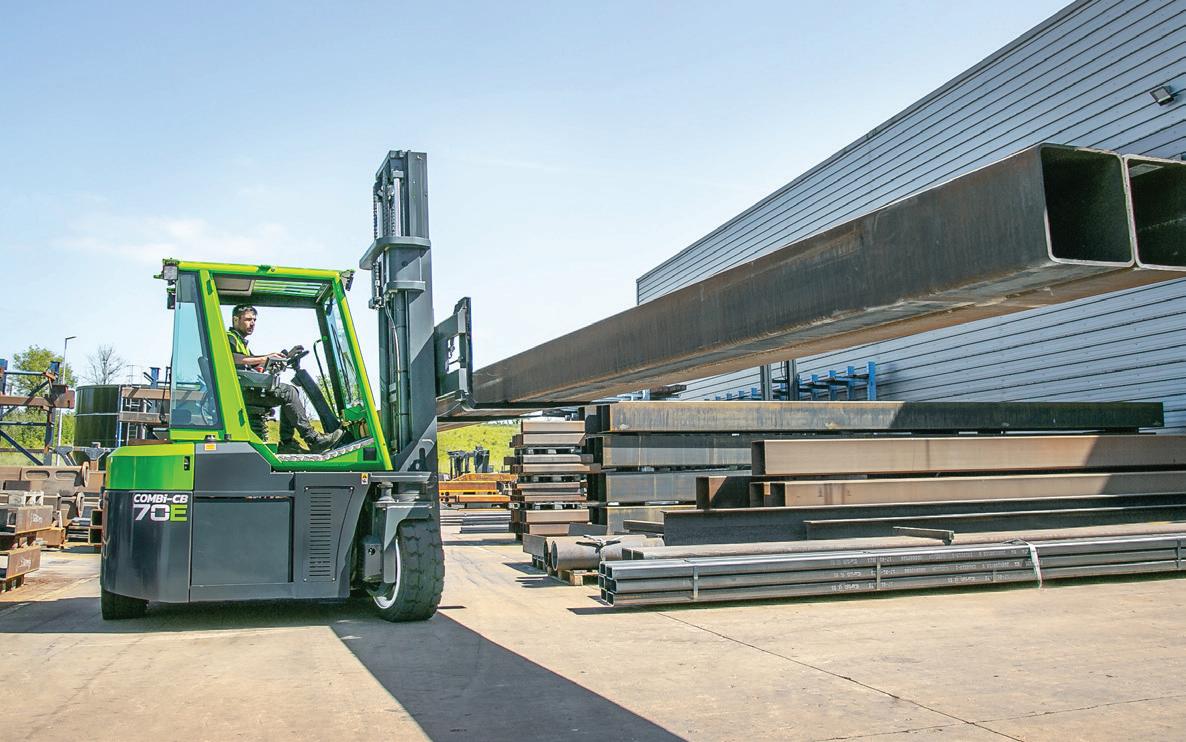
www.steeltimesint.com Digital Edition - August 2023 24
LATIN AMERICA UPDATE 25 Introducing
Amazing performance, extensive battery life and unrivalled ergonomics combined with all the advantages of the Combi-CB range make the CB70E the most powerful, compact multidirectional forklift yet.
Contact Us Today combilift.com
Fuelling the fire
STEPPING towards sustainable growth in the steel industry, India is working on strategies to ramp up coking coal production in government-operated domestic mines. This initiative aims to strengthen the raw material supply and reduce reliance on imports. Coking coal, also known as metallurgical coal, is a crucial fuel in the blast furnace process for primary steelmaking, as it is used to produce high-quality coke. Consequently, the demand for metallurgical coal is closely coupled with steel consumption, and primary steel producers prioritize securing a sustainable supply of coking coal to capture the opportunities in steel production. Various grades of coking coal, including hard, semi-hard, semi-soft, and pulverized material for injection, are used in steelmaking. Approximately, 0.8 tonnes of coking coal are required for every 1 tonne of steel production, in addition to other raw materials such as iron ore and limestone. However, India currently has meagre reserves and production of coking coal, and it does not feature prominently in the global ranking of coking coal producers. The country’s coking coal reserves have remained stagnant over the last several years, leading to low availability and poor quality of the material in the domestic market. While total coal reserves in India increased to 7 billion tonnes during 201415, there was little to no addition to the coking coal reserves or prime category mines. According to the Ministry of Mines, India’s prime coking coal reserves currently stand at 5.31 billion tonnes, with proven reserves at 4.61 billion tonnes. The total cumulative coking coal reserves, including proved, indicated, and inferred reserves, have only increased by 333Mt to reach 34.40 billion tonnes from 34.07 billion tonnes. As a result, growing steel production in India has led to a significant increase in coking coal imports, which have surged by nearly 65% in recent years, while
steel production itself has increased by 36%.
Steel production growth
India has experienced a remarkable increase in steel production over the past 10 years. Starting from 56.72Mt/yr in the financial year (FY) 2012-13, India’s steel production has surged to 125.3Mt/yr in FY2022-23, enabling the country to meet domestic demand and boost exports. As a result, India has transitioned from being a net steel importer to becoming a net exporter of steel. During this period, India has also witnessed a significant rise in iron ore production. However, the growth in coking coal production has not kept pace with the speed of steel output expansion.
Data compiled by the Indian
*India correspondent, Steel Times International
government’s Ministry of Coal reveals that coking coal production in India has increased by only 18% in the last 10 years, despite growth of around 150% in steel output. India’s coking coal production reached 60.77Mt/yr in FY2022-23, compared to 51.58Mt/yr in FY2012-13, with intermittent fluctuations. Although the Indian government successfully increased coking coal production at local mines, overall production remains significantly lower than demand. Consequently, coking coal imports in India have soared over the past 10 years. Imports rose from 35.56Mt/ yr in FY2012-13 to 54.46Mt/yr in FY202223. Additionally, non-coking coal imports in the country increased from 110.23Mt/yr to 162.46Mt/yr in FY2022-23.
Coking coal plays a crucial role in steel

INDIA UPDATE 25 www.steeltimesint.com Digital Edition - August 2023
Production Dispatch 2012-13 51.58 55.86 2013-14 56.82 58.46 2014-15 57.45 56.44 2015-16 60.89 59.21 2016-17 61.66 59.31 2017-18 40.15 45.38 2018-19 41.13 43.32 2019-20 52.94 50.66 2020-21 44.79 44.00 2021-22 51.70 54.40 2022-23 60.77 53.28
Coking coal production has witnessed a rapid rise in India, but still lags far behind the country’s growth in steelmaking. Dilip Kumar Jha*
Production and dispatch of coking coal in India (Mt) Financial year (April-March)
India’s
Financial year (April-March) Coking coal Non-coking coal Total coal 2012-13 35.56 110.23 145.79 2013-14 36.87 129.99 166.86 2014-15 43.72 168.39 212.10 2015-16 44.56 159.39 203.95 2016-17 41.64 149.37 191.01 2017-18 47.00 161.25 208.25 2018-19 51.84 183.51 235.35 2019-20 51.83 196.70 248.54 2020-21 51.19 164.05 215.25 2021-22 57.16 151.77 208.93 2022-23 54.46 162.46 216.92
Source: Ministry of Coal, Indian government
import of coal and coking coal (Mt)
Source: Director general of commercial intelligence and statics (DGCI&S), Indian government
manufacturing through the blast furnace route. However, the coking coal available in Indian mines contains a high ash content ranging from 18% to 49%, making it unsuitable for direct use in blast furnaces. To mitigate this, coking coal is washed to reduce the ash percentage. Indian prime and medium-grade coal with ash content below 18% is blended with imported coking coal with ash content below 9% before being used in blast furnaces.
Meanwhile, the government-owned Coal India Ltd (CIL) has continued to increase its production. The company reported a 17.2% increase in coking coal output to 54.6Mt/ yr in FY2022-23 compared to 46.6Mt/ yr in the previous year. The significant increase of 8Mt/yr surpassed the country’s production target for FY2022-23 by over

electric arc furnace (EAF). However, to meet this steel production target, India will need 170Mt/yr of coking coal. To address this, the Indian government launched the Coking Coal Mission, which focuses on new exploration, production enhancement, capacity augmentation for coal washing, and the auction of new coking coal mines. The Mission’s key objectives include increasing coking coal production from 52Mt/yr in FY2021-22 to 140Mt/yr by FY2029-30 and enhancing coking coal washing capacity from 23Mt/yr in FY202122 to 61Mt/yr by FY2029-30.
To achieve these targets, the public sector coal miner CIL has been assigned a production target of 105Mt/yr, while the remaining 35Mt/yr will come from other sources, including allocated coal blocks.
Most auctioned mines to start by 2025
To increase the production of raw coking coal, the Ministry of Mines recently conducted auctions for 10 blocks, allowing the private sector to boost production from domestic sources and reduce dependence on imports. Most of these mines have already begun project work and are scheduled to start commercial production by 2025. CIL, which accounts for over 80% of domestic coal output, has plans to increase raw coking coal production from existing mines up to 26Mt/yr. They have also identified new mines with a combined peak-rated capacity of about 22Mt/yr. Furthermore, CIL has offered eight discounted coking coal mines (out of the total 30 discounted mines) to the private sector using an innovative revenue-sharing model, with a peak rated capacity of 2Mt/yr.
In another effort to increase India’s coking coal production, the Coal Ministry has identified four additional coking blocks. Additionally, Central Mine Planning and Design Institute (CMPDI) is finalizing a geological report for four to six new blocks which will be offered in subsequent rounds of auctions for private sector participation in order to further enhance domestic raw coking coal production.
107%. India’s Ministry of Coal has set a target for CIL’s coking coal production at 105Mt/yr by 2030. Bharat Coking Coal Ltd (BCCL) and Central Coalfields Ltd (CCL), the two Jharkhand-based subsidiaries of CIL, were major producers of coking coal, with a combined output of 54.3Mt/yr in FY2022-23. BCCL accounted for nearly 62% or 33.7Mt/yr of total production during FY2022-23, a 16% growth compared to the previous year’s 29Mt/yr, while CCL recorded an output of 20.6Mt/yr, reflecting a 20% growth over the previous year.
Mission 2030
The National Steel Policy 2017 aims to achieve a steel production target of 300Mt/ yr in India. Out of this, the blast furnace route is expected to account for 180Mt/ yr, while the remaining 120Mt/yr will be produced through other routes including
However, even if India achieves its coking coal production targets as planned, steel mills will still need to import approximately 30Mt/yr of coking coal by 2029-30.
Nevertheless, the government has taken several steps to explore new coking coal blocks, auction new mines, enhance raw coking coal production, and expand washing capacity. In line with the Coking Coal Mission, CIL has made continuous efforts to enhance coking coal production by adding capacity to existing mines and opening new blocks. Additionally, CIL has implemented mass production technology in its underground mines to increase raw coking coal production. The company has also offered coking coal blocks to the private sector (including some discounted mines) on a revenue-sharing basis through the Mine Developer and Operator (MDO) route.
In terms of raw coking coal washing, India currently has a total capacity of 23Mt/ yr, with the private sector accounting for 9.26Mt/yr. However, CIL is now planning to establish and operationalize nine new washeries with a capacity of 30Mt/ yr. This move will enable CIL to supply approximately 15Mt/yr of washed coking coal to the Indian steel sector. The total supply of washed coking coal by CIL to the steel sector was recorded at 3.45Mt/yr this year compared with 1.7Mt/yr the previous year.
Conclusion
Despite being the second largest producer of crude steel globally, India does not feature in the list of countries with significant coking coal reserves. Furthermore, the inadequate quality of coking coal for direct use in steelmaking necessitates a considerable capacity expansion for coal washing.
As a result, India requires substantial investments in discovering new mines and developing washeries to achieve selfsustainability in coking coal production in line with the ‘aatmanirbhar’ (self-reliance initiative). �
www.steeltimesint.com INDIA UPDATE 26
Digital Edition - August 2023

Pursuing greener operations in the steel industry

THERE is a growing focus in the steel industry on the use of technologies to manage energy consumption effectively. Organizations in energy-intensive industries such as steel recognize the need for additional energy, particularly when it comes to renewable or green energy sources.
However, the availability of multiple energy sources such as solar, wind, and nuclear creates a dynamic and open market for these companies. To remain profitable and improve margins, these organizations need to manage their energy needs and mitigate associated risks.
The role of technology in transforming traditional approaches
New technology and software play a crucial role in addressing these challenges. Traditional approaches to purchasing energy from a fixed-price utility source are no longer viable. Companies now need to determine where to source their energy and how to align it with their production requirements. They must consider the timing of energy acquisition, storage options, and base load requirements.
Managing complexities manually can be challenging given the dynamic nature of the energy market. Therefore, new technologies, such as artificial intelligence, can assist in analyzing production needs, market availability, and potential disturbances. This allows companies to make informed decisions such as adjusting production levels to mitigate risks associated with fluctuating energy prices. The steel industry alone is currently responsible for 9% of global emissions. In the pursuit of greener operations, steel companies must also consider the entire supply chain of energy to ensure it comes from sustainable sources – particularly when transitioning from CO2-intensive blast furnaces to electric arc furnaces. While companies may reduce their scope one and scope two emissions by eliminating coal usage, the origin of their electricity must be considered. Scope three emissions encompass the entire supply chain, so using electricity from a coal-based provider may not align with their goals of producing green steel. Technology can help in identifying and analyzing the proper sources of energy, enabling companies
to make more sustainable choices where possible.
Strengthening the industry with Artificial Intelligence (AI)
AI has the potential to revolutionize the future of steel plants globally by playing a big role in improving energy efficiency and productivity. Firstly, AI can monitor realtime energy consumption in a plant and identify areas which are wasting the most energy across plants. By alerting operators and providing solutions to save energy, AI simplifies the process and reduces unnecessary equipment usage, saving on overall costs.
It can also optimize energy consumption during repetitive production cycles by comparing current energy usage to past optimized levels. Once this is complete, operators can take measures to improve energy efficiency based on AI insights. Forecasting future data and emissions using predictive analytics can help optimize operations and reduce energy consumption. Additionally, AI can be integrated into energy management systems to forecast future energy prices and
DECARBONIZATION 28 www.steeltimesint.com Digital Edition - August 2023
*Development lead, green steel, Schneider Electric. **Global industry principal, mining, metals and minerals, AVEVA.
Technological innovations are making it possible for the industry to accelerate the pace of industrial decarbonization, allowing producers to monitor and optimize production, and enabling proactive decision making.
By Mo Ahmed* and Martin Provencher**
weather conditions, and plan production accordingly. AI-driven forecasting can enable proactive decision-making and minimize production disruptions due to energy fluctuations. With advancements in AI already transforming the sector, organizations need to remain alert about the potential of autonomous operations in the future and what that might look like for their plants, although safety considerations remain crucial.
Going beyond: Unified Engineering Unified Engineering uses advanced engineering tools that go beyond traditional paper drawings and enable real-time collaboration and digital twins. Organizations have begun understanding the true benefits of using these advanced tools to transform their plants. By working in real-time and generating a live digital twin of the plant, engineers can improve efficiency, reduce rework, and lower engineering costs.
This unified approach also guarantees the connection of data throughout the plant’s lifecycle, enabling the creation of a digital twin that can be used for simulations and training. Operators can receive training in a safe simulated environment, reducing exposure in high-risk areas until they are fully trained. Simulation using the digital
twin can also help test new production scenarios and optimize processes before implementing them in the actual plant, minimizing the waste of time and resources on physical trials and errors.
Unified Engineering and digital twins contribute to overall improvement, including shortened project delivery times, enhanced engineering efficiency, safety for operators, and the ability to break down silos and improve communication through unified operation centres.
Digitizing the digital twins
One key aspect of utilizing digital twins is the combination of engineering drawings and 3D modelling with near real-time operational data. This allows companies to effectively operationalize the digital twin and manage it for improved asset management. It’s crucial for projects involving the replacement of blast furnaces with green steel initiatives, such as DRI and electric arc furnaces.

Engineering, procurement, construction, and project management (EPC-PCM) companies are responsible for managing these engineering projects. However, a challenge arises when operators begin using the assets continuously for 24/7 operations, as troubleshooting becomes difficult without proper digitalization.
By implementing digital engineering solutions and having access to detailed digitalized engineering data, operators can easily locate and troubleshoot problems, ensuring smooth operation and improved performance of these green assets.
Digital engineering strategies that provide a digital version of projects and assets are vital to facilitate troubleshooting, modifications and successful project start-up. Another important aspect is the utilization of operational data throughout the entire lifecycle of operations. Monitoring and near real-time analyzing operational data, particularly through descriptive analytics, allows for insights and efficiency improvements. This initial step provides valuable information to human analysts, even though more advanced analytics and AI-driven predictive capabilities can be pursued in the future. Managing and analyzing operational data is crucial for enhancing operational efficiency and driving improvements in various areas, including energy consumption.
Setting realistic targets
Organizations need to set realistic improvement targets and energy benchmarks for progress. An overall energy strategy is needed, which can include factors such as baseload variations, securing fixed prices, buying from the open market and determining the energy mix.
Managing energy costs and sources on a day-to-day basis is crucial due to fluctuations in production, market situations, weather impacts and unforeseen incidents. Electrical energy costs constitute a significant portion of around 30% to 40% of production costs in the transition towards green practices. Managing and mitigating risks related to energy sources and costs becomes a key aspect, as it is equivalent to managing half of the raw material.
Technological breakthroughs allow green steel to become a reality
Fortunately, technological innovations are making it possible for the industry to accelerate the pace of steel decarbonization. Technologies such as AI and digital twins are already transforming how the sector can adapt and catch up with other industries when it comes to adopting technologies to improve not only sustainability but also efficiency and productivity. �
DECARBONIZATION 29 Digital Edition - August 2023
Data analytics and AI for energy and emission control

Disruptive technologies such as AI, machine learning and advanced data analytics –combined with deep domain knowledge and investment in a digitally literate workforce – are the key to improving sustainability and productivity in energy-intensive process industries, explains Sanjit Shewale*
THE digitalization of the process industries – including the steel industry – continues apace, with innovations such as artificial intelligence (AI), machine learning (ML) and advanced data analytics offering unprecedented visualisation and pattern recognition capabilities, recommending optimal actions for every stage of the value chain.

Armed with these granular insights, industrial companies can make informed, data-driven decisions that drive genuine

ARTIFICIAL INTELLIGENCE 30 www.steeltimesint.com Digital Edition - August 2023
*Global head of digital business line, VPGM, Process Industries Division, ABB.
Fig 1. Energy-intensive process industries are evolving
business value, reducing both OPEX and CAPEX while improving safety, protecting their reputation, boosting environmental, social and governance (ESG) credentials and complying with evolving regulations. (Fig 1)
Given these strong business imperatives, it is surprising, therefore, that many energysaving and emission reduction opportunities remain untapped. Plant owners who
adopt digital solutions can look forward to better performance at a reduced capital cost, as well as overall standardization of environmental practices, a significant help in reducing and managing their inherent complexity.

Domain knowledge is important
In addition to the recurrent challenges of optimizing efficiency, and maintaining throughput and quality control during highvolume production, chemical processing companies must now comply with laws aimed at reducing emissions in line with the 2015 Paris Agreement – or face penalties.
The whole energy ecosystem is also evolving – and while this transition is not without its challenges, the enabler is most definitely digital technologies. However, it is important to note from the beginning this simple fact: just gathering data in a pool and then applying AI and ML will not magically transform industrial operations. What is often missing is a conceptual understanding of how the data got into that pool – and how it can best be leveraged to add real value to a business. Many technology/software companies dive into a project without having a clue about the industry. They make false promises. ML requires a lot of data – with data classification and management approach closely aligned to the business strategy. It also requires specialists able to literally teach machines how to structure their computing methods more like human thought, how to solve complex industry-specific tasks by breaking them into simple steps and how to self-monitor for effectiveness. Partnering with a trusted
technology provider with deep domain knowledge and expertise is a prerequisite of success, and an incredible opportunity for companies and people who understand how to navigate the digital storm.
In short, the role of people in solving challenges around accuracy of AI techniques and how to explain them must not be underestimated – so that machine recommendations can be trusted. Data cleansing, anomaly removal, analysing the correlation of parameters and proper result interpretation are as important as ever; after all, if you trust the people, you trust the algorithm. I will talk more about investment in human capital later.
Case study 1: Decarbonizing steel production
When we talk about decarbonization potential across industries, it is really the additional ‘horsepower’ provided by advanced data analytics, AI, and ML that is the gamechanger. For operators in the process industries, it will be impossible to hit KPIs and tighten sustainability targets by manual setpoint adjustment alone, and this not only concerns emissions reduction, but also energy optimisation and management. As more and more data is there, and with the implementation effort decreasing, we will see more and more people getting involved in AI advisory – driven by corporate decarbonization initiatives.
We engineers know that it is easier to speak about ML than to implement it. We get excited about addressing the untapped opportunities in process industries, especially sustainability. But we also get practical and pragmatic, starting with examples of how data has already been used successfully.
Let’s take a real-life example of a steel plant with an annual capacity of up to 5Mt. (Fig 2).
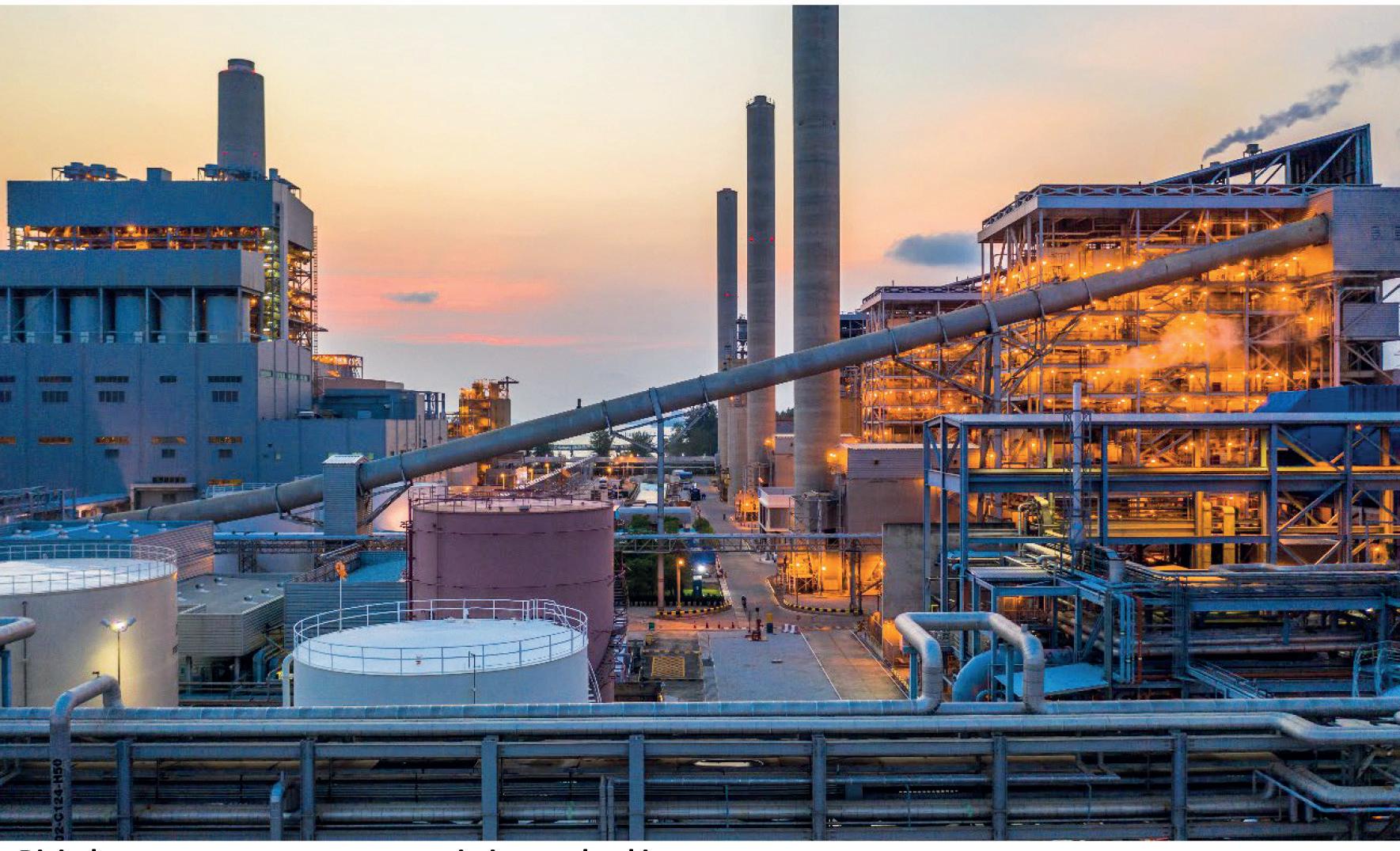
Complex distribution networks for electricity, steam, by-product gases and imported fuels account for as much as 20% of production costs. Iron ore reduction is where the vast majority of carbon emissions come from in steelmaking, but the world will continue to rely on iron ore until around 2100. The challenge for the industry in the coming decades must, therefore, be to transition to alternative, preferably renewable, sources of energy and optimize their use for iron ore reduction.
ABB’s Digital Energy Management solution has a proven track record of short
ARTIFICIAL INTELLIGENCE 31 www.steeltimesint.com Digital Edition - August 2023
Fig 2. Digital energy management can optimize steelmaking processes
payback times and long-term benefits. It not only optimises production scheduling, throughput and quality, but also energyrelated costs, raw material usage, carbon, greenhouse gases and waste emissions. As mentioned, it relies on decades of experience in the process industries – and steelmaking in particular – captured in rule-based predictive energy management algorithms.

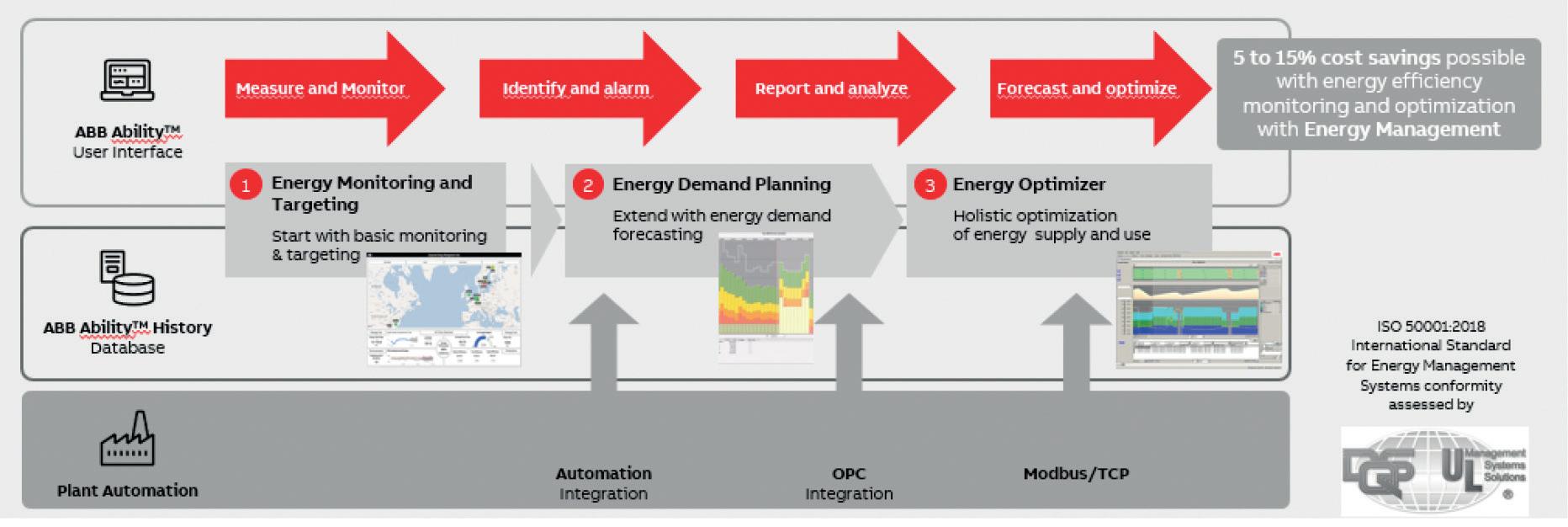
Designing, deploying and maintaining the optimal site-wide or enterprisewide energy management and emission control strategy is a large engineering and operational challenge, one that requires a wide span of competencies, engineering tools, architecture approaches and service capabilities in order to identify the most performing and cost-effective solution for each process area and site.
Typical steps and a modular approach for deploying a digital energy management system are:
Monitor: Monitoring energy usage at plant and process level with real-time visual displays and data
Identify: Identify best performance of process areas and opportunities for improvement
Report: Report energy consumption patterns (process areas, production lines)
Analyse: Analyse inefficiencies in plant and process areas
Alarm: Alarm capabilities – enable corrective measures to be taken immediately
Forecast: Forecast energy consumption schedules for process areas based on production plans and measured
consumption
Optimize: Solve economic real-time optimization problems consisting of generation, trading and usage of energy in industrial plants and power plants (Fig 3)

Waste gas utilization in metals production can be greatly improved by monitoring generation and consumption across plant facilities in real time. Data is collected from multiple systems to compare allocation with actual consumption, provide real-time demand and supply calculations, balancing, benchmark and optimal distribution, as well as forecasts based on production plans and historical data modelling. Root cause analysis is also applied when a gap occurs between supply and demand. (Fig 4)
Deploying data with edge computing power
Digital energy optimization is a perfect use case for both AI and ML, with multiple data sources and concrete problems to solve. Complementing these management systems with data contextualization and digital twins allows operators to further optimize their energy consumption using load profiling and balancing and process parameters; air temperature at the compressor intake, for example.
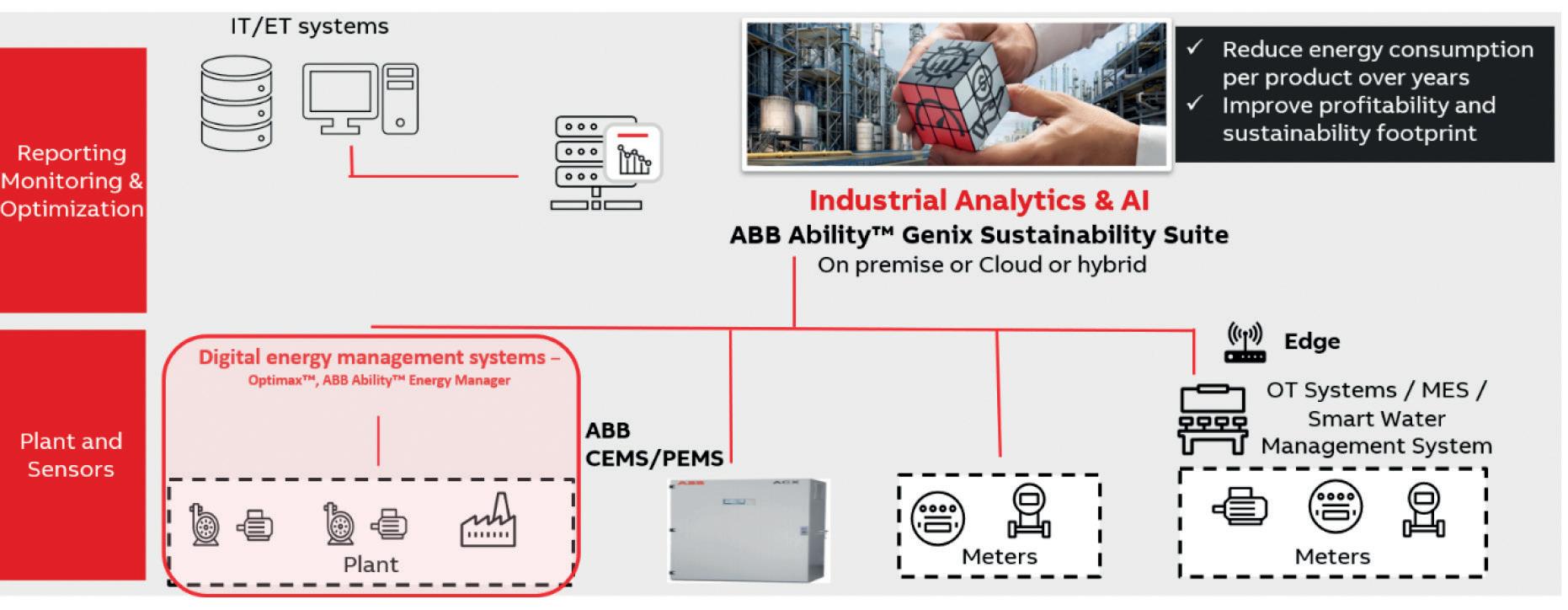
ARTIFICIAL INTELLIGENCE 32 www.steeltimesint.com Digital Edition - August 2023
Fig 3. Deploying digital energy management system in a modular approach
Fig 4. Byproduct gases network optimization
Fig 5. System anomaly detection on asset or system energy consumption deviations and alerts
Fig 6. Integrated decision support system to drive continuous performance improvements
As another example, a complementary System Anomaly detection app can be deployed to detect unusual patterns and anomalous behaviour from process streaming time series data. It uses AI/ML methods to continuously monitor changes in pattern across IT and OT systems from high frequency near real-time data.
By triggering alerts, it helps reduce manual efforts needed to identify and rectify energy consumption deviations. (Fig 5)
The latest enterprise-grade platforms and suites of AI and ML enabled applications enable companies to deploy and monitor advanced controllers, data analytics and optimization solutions at the edge, to and from an industrial cloud/multi-cloud, or on-premises.
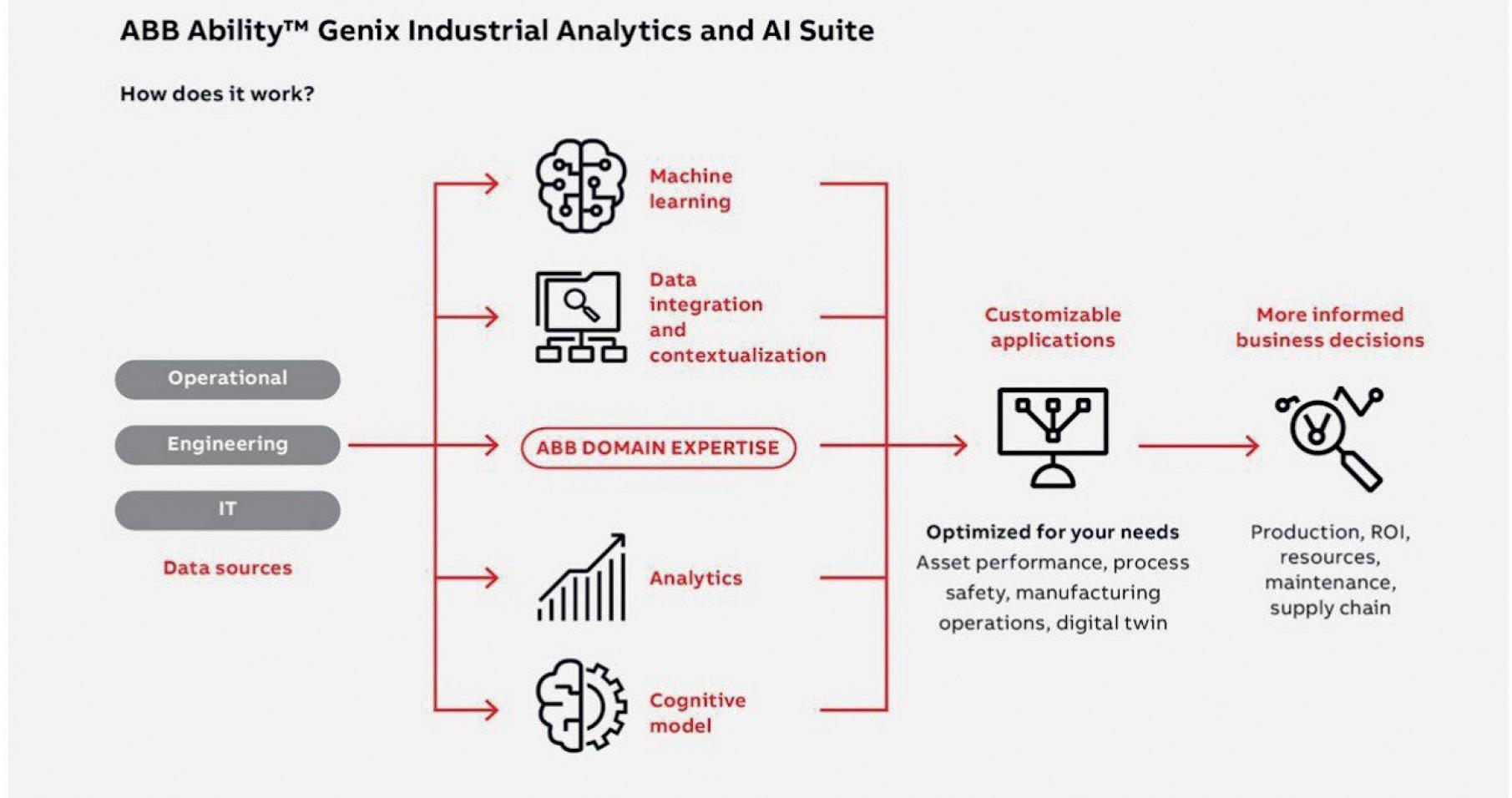
However, this increased complexity requires digital solution providers to have the ability to master very different technologies, industry-specific processes, cybersecurity and offer the needed consultancy and assistance to end users from the early design stages to system commissioning and maintenance.
Summary and key benefits
The steelmaking plant mentioned has reported initial results of 10% less flaring of gases and 15% accuracy improvement of electricity procurement forecasts. Site-wide optimization of energy consumption and availability was a key factor in achieving the results as the solution covered steam yield, by-product gases, energy purchase and production, including site power plants and turbines.
In addition, there are further opportunities to scale and enhance installed digital systems based on the latest edge computing, cloud, visualization, AI and ML technologies; for example, by using analytics for adaptive re-modelling and tuning, including additional variables for optimization.
Taking a wider view, visualizing the top steelmakers’ strategic roadmap versus available technologies ripe for analytics and ML demonstrates just how big the potential is for digitally optimizing energy use in the industry. Policymakers are also looking at best practices to set and track adequate targets. (Fig 6)
A multitude of research is ongoing in areas such as process-specific data models and simulations, carbon capture, utilization and storage, or making green hydrogen a financially feasible option.
Encouragingly, this will help steelmakers shift away from current production
methods towards completely new ways of improving energy efficiency, reducing energy cost and carbon footprint.
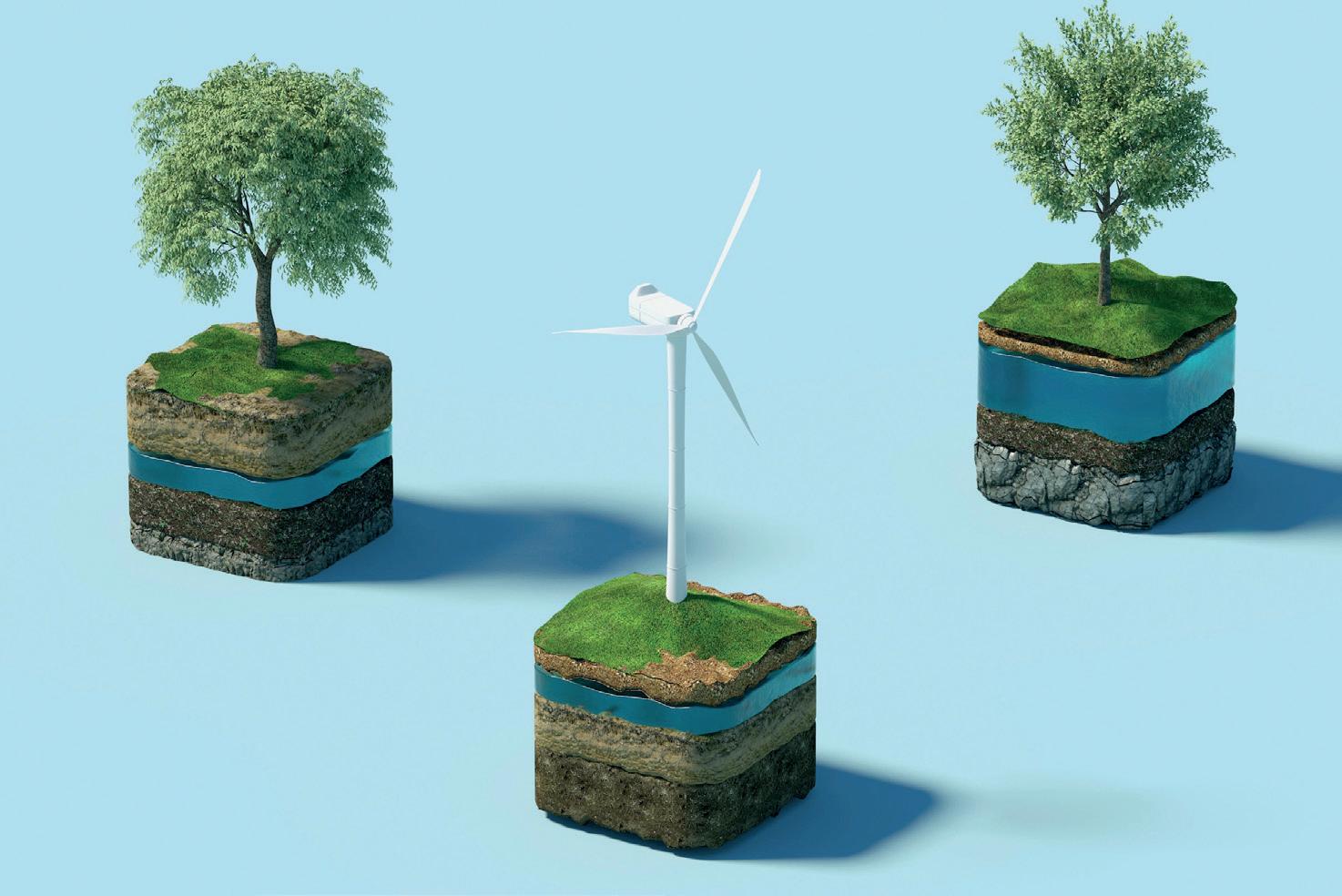
Investing in human capital
This successful collaboration between humans and machines is fundamental for the steel industry to reap the full benefits of industry 4.0 innovations when it comes to sustainability.
As engineers, we are good at domainspecific knowledge, intuition, creativity, empathy. Conversely, machines are good at large data sets, calculations, learning, automation and pattern recognition. The company that can marry the two successfully will enjoy competitive advantage in the digital future.
Sustainability-related actions mean different things to different people depending on their job function, and they experience varying degrees of difficulty when it comes to locating and analysing data across their organization. An industrial-grade analytics and AI platform helps you get the most from federated data sources – your existing control systems, IoT devices, MES, ERP, CMMS, engineering and other databases.
Contextual Data Fusion tools automate data integration, letting operators identify previously hidden relationships and performance trends, make timely predictions and accurate forecasts. The business value from taking this holistic view is tailored to specific roles and enables cross-enterprise actions.
However, this can only be achieved if you trust people who are building the optimization models for specific use cases: their deep process expertise, the know-how of your industry. Now, their expertise and ingenuity can be captured and shared on a
ARTIFICIAL INTELLIGENCE 33 www.steeltimesint.com Digital Edition - August 2023
Fig 7. ABB’s approach for data and analytics and AI in process industries
common platform – augmented with edge, cloud and ML technologies for maximum impact. Industrial analytics help various functions in all industries to collaborate, augmenting human abilities with AI/ML, and focusing on solving concrete problems.
Earlier, I mentioned investment in people and its importance to the digital transition. In this context, when we talk about technology being ‘disruptive’, we don’t just mean in terms of quantifiable, statistical gains around efficiency and sustainability: we also mean culturally within an organization.
When we talk about the digital transformation, we often do so in terms of futuristic technology, but in fact, if it’s done well, it is more a commitment to continuous improvement and perpetual change – in order to stay relevant. Therefore, I prefer the term DigitalOps. Practicing DigitalOps means continuously discovering, modelling, analysing, combining, extending, and optimizing business processes in a way that allows companies hit their KPIs around operational excellence, sustainability, process and asset performance, safety, and productivity of connected workers.
It also means looking differently at cyber security – as an enabler and accelerator of DigitalOps, defending your business in a dynamic, strategic way.
Understandably, many people ask: “Is my job at risk or will it vanish as a result of digitalization and automation?” This is the wrong question. Certainly, many personnel in the process industries will see
the way in which they work fundamentally transformed, but the real question should be: “How can I best apply and adapt my existing skillset to allow me to be relevant and prosper in the brave new world of digital?”
There is a significant shortage of skilled labour in the process industries. The onus is on companies to demonstrate that they are serious about ESG policies and innovation if they wish to attract the next generation of digitally literate talent to whom issues such as climate change are a genuine concern.
The technology transition must be supported by the transformation of processes and people. How well a specific solution solves a use case is often not as important as how it fits within the overall operational business culture. Unfortunately, successful change management is often overlooked7
Accelerating the use of AI
AI is transforming industry. One way that ABB develops AI capability is through making low-code/no-code solutions accessible to more people and letting them capture ‘tribal knowledge’ on a common platform. Among other activities, the company collaborates with industry consortia, innovation-driven start-ups and conducts the ABB Industrial AI Accelerator programme to drive the next level of the industrial revolution via such collaborations.
(Fig 7)
AI, often dubbed ‘the next technology frontier’ or ‘the Intelligence Revolution’, is one area where collaboration can make
all the difference. AI has the potential to enhance human capabilities in a range of industries. AI is still a growing field; in terms of venture capital investments it is one of the best-funded sectors.
Large firms in almost every industry are trying to integrate AI capabilities into their offerings. According to the AI Index Report 2019, globally, investments in AI start-ups have increased at an average annual growth rate of more than 48% since 2010 (2018: $40.4bn).

Investing in the digital future
It is in the interest of all the process industries to invest in their digital future, particularly when it comes to decarbonization and carbon neutrality. The new EU carbon border tax, for example, will apply to electricity, iron and steel, aluminium, fertilizers, and cement. Against this backdrop, an effective, coherent sustainability strategy is no longer a ‘nice to have’, it is a business imperative.
Conclusion
In conclusion, technological innovations such as AI, ML and advanced data analytics, provided by a specialist technology vendor with proven domain knowledge, operated by a motivated, digitally literate workforce, and backed by meaningful long-term investment have tremendous potential to optimize energy management and emission control in the steel industry, allowing companies to hit environmental targets and contribute to a cleaner, safer, more sustainable world. �
ARTIFICIAL INTELLIGENCE 34 www.steeltimesint.com Digital Edition - August 2023
CONNECTING THE INTERNATIONAL STEEL INDUSTRY

Magazine
Steel Times International is the key publication for the steel market, reporting on iron and steel making issues from all corners of the globe.
Directory
The Steel Times International Directory is the essential guide to steel manufacturers, producers, suppliers of plant equipment and services to the steel industry. Order your print or digital copy priced from £105 or subscribers.
Website











Packed with information on the steel industry and continually updated with news for steel professionals, www.steeltimesint.com features special articles and interviews with leading industry gures.
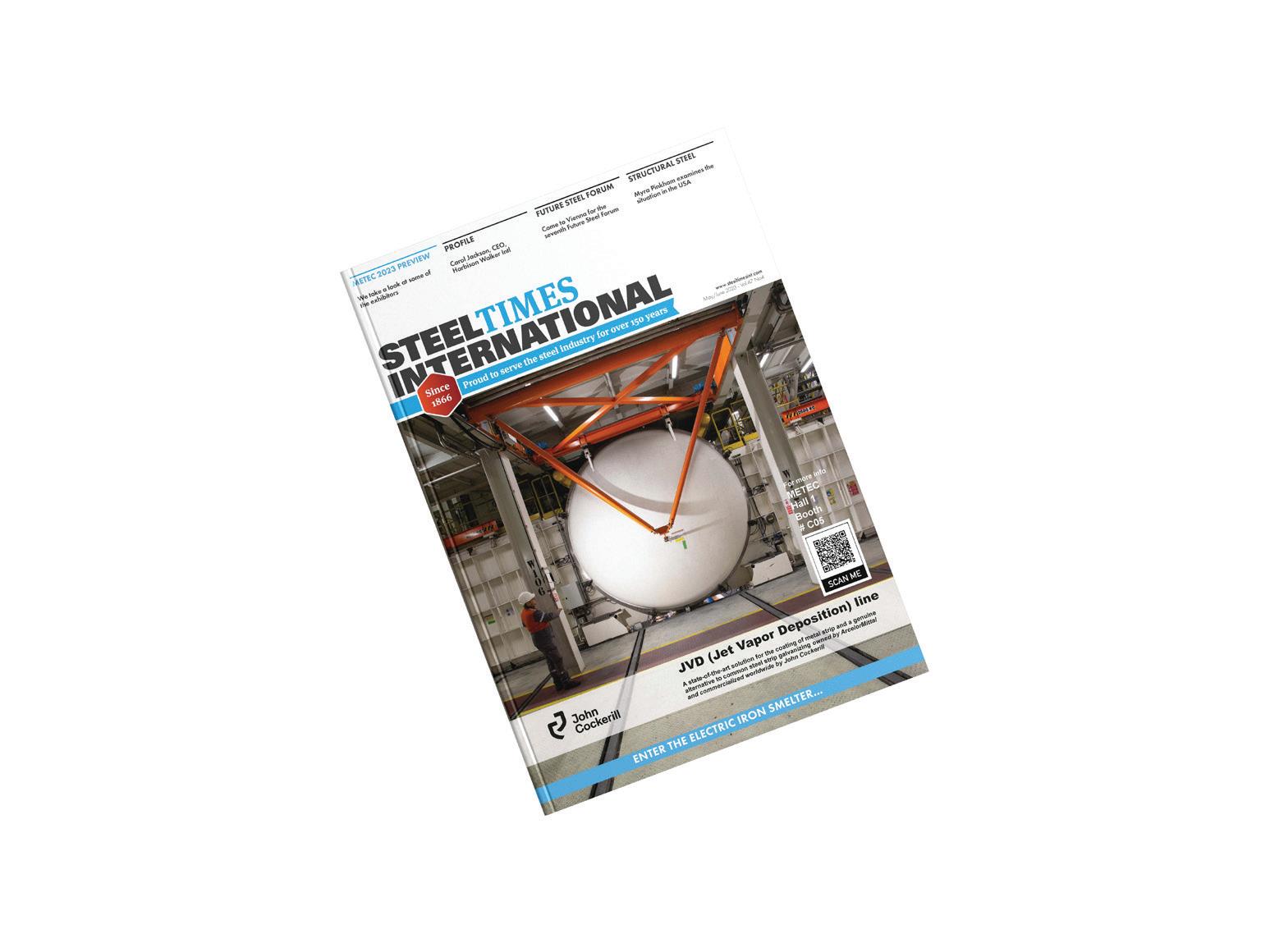

Newsletter
A round-up of the top news stories is sent to more than 7,000 industry professionals each week. You can register online to receive the weekly newsletter and keep up-to-date with the latest news from across the steel manufacturing industry. www.steeltimesint.com/e-newsletter
Online Events
Since 1866 BUSINESS MEDIA LTD PUBLISHED BY FIND OUT MORE AT STEELTIMESINT.COM Join the Steel Times International Group @SteelTimesInt
Adapting to demand
The industry faces a multitude of challenges, such as excess capacity, oversupply and high raw material and energy costs – but through the adoption of digital technologies, companies can overcome issues and reap the rewards of new opportunities.
By Sheeraz Khateeb*
STEEL producers today are dealing with a myriad of diverse and complex challenges. The sector is becoming ever more complicated by trade wars, it employs an ageing workforce rapidly approaching retirement, and this is all set against the backdrop of a market still expressing overcapacity concerns. The industry is already amidst a transformation with the next technological revolution, and a global pandemic has exacerbated this. However, it is not all woe for the steel sector as demand is picking up faster than
expected, and financial ratings are more stable than five years ago. And while it may still take several years for industrial activity to return to pre-pandemic levels, the rebound the industry is seeing provides an improved outlook.
The steel landscape continues to grow increasingly complex as the industry works to meet these challenges. Steel companies are shifting how they do business. What was deemed a successful strategy a decade ago no longer works in the current, highpaced environment. Only those companies
working to better address challenges and take advantage of new opportunities will reap the benefits.
The challenges faced are multiple and diverse, ranging from excess capacity, oversupply and a competitive environment, high raw material and energy costs, the need to decarbonize and adopt a circular economy strategy, the demand for new steel products, and changing workforce demographics. While the industry’s challenges are significant, steel companies have options to mitigate the associated risks
*Software channel manager, Middle East, Turkey and Africa, Rockwell Automation.

DIGITALIZATION 36 www.steeltimesint.com Digital Edition - August 2023
by adopting digital technologies.
The pathway to a profitable and sustainable future comprises of the digital transformation of the steel sector, utilizing digital technologies to migrate towards the connected steel plant by improving process efficiency, enhancing asset management, integrating the mine-to-shelf supply chain, and embracing the connecting worker. The connected steel plant links businesses, processes, assets, and people to provide a holistic view of the operation. Customers can view contextualized asset information, optimize operations, and reduce downtime by smartly managing maintenance activities.
The four enabling technologies for future steel production



The pathway to a connected steel plant can be achieved through aggregating and displaying data in a single pane of glass, in a comprehensive powerful IIOT platform that seamlessly integrates with Manufacturing Execution Systems (MES)/ Manufacturing Operations Management (MOM) and Cloud-based computerized maintenance management systems. The IIOT system provides fully connected information and enhanced assistance through augmented reality to empower

DIGITALIZATION 37 www.steeltimesint.com Digital Edition - August 2023
workers.
The integrated operations centre brings all this together and delivers all the vital data to one centralized location. It enables manufacturers to easily access production performance, order and quality management, and track and trace products and materials.
Aggregating, contextualizing, and displaying information from disparate systems
The foundation of an industrial digital transformation requires software built to support an ecosystem of advanced industrial applications, including IoT. It starts at the edge, where manufacturing happens, and scales from on-premises to the cloud. The result is supercharging your industrial environment with software that offers cutting-edge design, maximizes operational efficiencies, and delivers predictive and augmented maintenance advantages.
Plex is a single digital cloud platform that is purpose-built for manufacturing. Plex offers the flexibility to connect, automate, track, and analyze all aspects of the enterprise. The platform allows users to improve performance and uptime with real-time equipment monitoring. For example, industrial IoT (IIoT) enables shop floor production and asset management tracking and can also centralize machine data collection from programmable logic controllers (PLC).
Rockwell Automation’s mosaic software (powered by Cognite Solution) brings to market a unique, unified, edge-to-cloud industrial data hub that makes operational, engineering, enterprise, and visual data understandable and comparable for the steel industry. This software will transform raw data into high-impact applications for real-time decision-making and improved workflows that ensure safe, productive, and sustainable operations. This information in conjunction with a powerful IIOT platform or FT Dataview software will provide holistic meaningful data to take enhanced prescriptive decisions.
Monitor and predict when an asset is about to fail
Steel manufacturers are under constant pressure to drive productivity and minimize downtime. Achieving this requires a data-driven, outcome-based industrial maintenance platform that can
provide specific support to help maximize productivity, reduce operational risk, and meet business goals. Steelmakers know how essential equipment uptime is, but many still rely on out-of-date systems to manage maintenance, meaning they miss red flags that can lead to costly problems, leaving them constantly reacting to breakdowns, missing important work orders, and having little insight into costs or maintenance performance.
Fiix is a cloud-based, AI-powered computerized maintenance management system (CMMS) that helps steel companies manage all their maintenance, including thousands of assets, work orders, and parts, with just a few clicks. Asset management tools allow manufacturers to easily view, analyze and act on all equipment information in one place, from triggering work based on real-time asset performance to tracking maintenance costs.
For many steel plants, FIIX also acts as an add-on for an ERP Plant Maintenance (PM) module, as it can be used to connect a PM module directly to the assets, PLC/DCS, and fleet to get metered information for condition-based, preventive and prescriptive maintenance. FIIX also enables connectivity using mobile applications, and this 360° approach enhances the usage of ERP PM modules.
Digital technologies for remote collaboration
The final leg of the connected steel plant is connected workers. Like many other sectors,
the steel industry needs qualified young workers to replace older workers who retire. This skills gap is a global challenge, and as it widens, it threatens to reduce productivity and slow time to market. Steel manufacturers must empower their workers to perform better and avoid safety and compliance risks by providing easy access to the necessary information.
They can use industrial Augmented Reality (AR) to improve workforce productivity, efficiency, and customer satisfaction with real-time, step-by-step work instructions. Vuforia AR solutions enable users to easily create and deliver consumable instructions with new or existing media content/capture, 2D & 3D content, sequences, IoT data, and real-time annotations in shared environments.
With AR, work instructions become hands-free and are delivered in real-time where operations occur. Tribal knowledge of experienced workers is quickly captured and shared with new workers and service technicians. Remote expertise can be delivered to workers no matter where they are in the world. AR training manuals and videos have become a thing of the past while AR training has been proven more effective and efficient.
Extracting full value from data
Within the connected steel plant, the ability to gain valuable business insights from the wealth of data available is crucial to success. One solution that empowers operators with a tool to achieve this is

DIGITALIZATION 38 www.steeltimesint.com Digital Edition - August 2023
Knowledge Lens. This solution is a collection of lenses that automate and simplify the discovery of hidden insights from big data. It can turn dark data into meaningful business insights and proved its worth in a recent project with a renowned Indian steel, power, mining, oil and gas, and infrastructure company.
The client’s operations and executive teams used to manually generate power business insight reports by downloading data from SAP HANA, RDBMS, and Excel, resulting in a time-consuming and errorprone process. To improve performance the client required an end-to-end automation solution to construct a data lake for business insight consumption.
The solution was to develop an enterprise data lake based on open-source technology and designed to serve as the central hub for all data processing in the company. In contrast to ingesting data into multiple RDBMS, all data was ingested into one data lake, which provided end users with secure access to perform analysis. To enable future scaling and eliminate SAP dependency it performed the required transformations in the data lake and built the final reporting tables. Similar data models can be used to improve the sustainability of steel manufacturing, this time through a solution called GLens. This is a real-time data acquisition, monitoring, and analytics suite of products for industrial emissions, effluent discharges, and ambient air monitoring.
GLens Client data acquisition software provides direct integration with any
analyzer (make or model) and provides secured encrypted data communication with a central server using open RESTbased API or MQTT-based protocols. GLens Environment provides a wireless data logger that eliminates the need for PCs for client-side data logging and can transmit data using the on-site network. GLens Mobile Application provides up-tothe-minute information on the data in the GLens platform for industry and regulator consumption.
Putting the connected steel plant into action
For one steel manufacturer, the pathway to increased efficiency through digital transformation involved developing a strategy and phased roadmap. The manufacturer wanted to develop strategies for individual divisions, merge those ideas into a single corporate strategy, and provide transparency across the board. The strategy needed to align divisional and corporate needs and realize the operational benefits of digital transformation to achieve longterm success.
The solution was to assess enterprise vertical integration to develop recommendations, business cases, and a roadmap by leveraging the Rockwell Automation Connected Enterprise framework. The engagement identified and prioritized opportunities for digital strategies, including IoT and MES projects based on business drivers. While the collaboration is in its early stages,
it is expected to have boosted labour productivity by 8%, reduced tooling costs by 10%, scrap by 13%, and downtime by 12%.
For another steel manufacturer, process improvements were driven by manufacturing analytics. While updating the plant’s control layer, IT teams began considering additional opportunities to improve operations. They found an issue with workforce utilization: operators’ attention was divided between creating tie plates and handling data.
Rockwell Automation provided solution integration between the control and information layers. Data about each batch is sent directly from the PLC controllers to a historian. Factorytalk Dataview software transforms data from disparate sources into digestible information for slice-and-dice analysis.
Before the user deployed the manufacturing intelligence platform, the annual yield was between 86% and 87%. By reducing the manual collection and reporting of data and gaining the ability to identify issues quickly, the yield has increased to an average of between 89 and 90%.
Turning strategic concepts into realistic solutions
Despite clear benefits, many steel producers face obstacles to embracing digital transformation. Projects may never get approval; and if they do, they do not deliver the expected results. Why is that? Without a clear business case highlighting the return on investment (ROI), many projects are denied by company leadership.

Developing a clear strategic roadmap is complex, but missing this key step often leaves plans at a standstill. Rockwell Automation Kalypso can help steel plants value the workshop to define the gaps and needs of a steel plant, which can help to build a business case.
Other roadblocks to project success involve focusing on new technology without a clear direction on the problems it will solve. Steel companies need help attracting talent and developing new skills. A proliferation of in-house applications, lack of scalable plans and difficulty integrating legacy infrastructure are also to blame. The steel industry can still implement many improvements when it comes to digital transformation implementation, and a valuable opportunity is being left on the table. �
DIGITALIZATION 39 www.steeltimesint.com Digital Edition - August 2023
CONNECTING THE FURNACES INDUSTRY


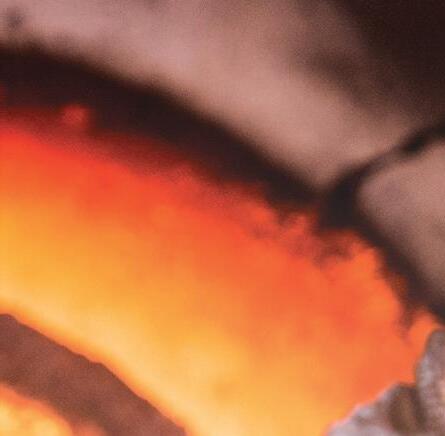

Digital Magazine
Furnaces International is an English language journal dedicated to the production of rnaces. Circulated each quarter in March, June, September and December to our database of over 20,000 readers across the Aluminium, Glass, Furnaces and Steel industries, Furnaces International contains a digest of global news, events, and statistics as well as more detailed technical articles, company and country pro les, and regular regional economic brie ngs.
Directory

The Furnaces International Buyers' Guide is the essential guide to rnace manufacturers and suppliers of rnace equipment and services to the industrial heating/process industry. Providing comprehensive company listings, product information and key contact details, the guide is published in December each year.

Website















Packed with information on the rnaces industry and continually updated with news for professionals, rnaces-international.com also features special articles and interviews with leading industry gures.
Newsletter


A round-up of the top news stories is sent to more than 44,000 industry professionals every month. You can register online to receive the weekly newsletter and keep up-to-date with the latest news from across the rnaces manufacturing industry. Sign up at
Other Publications
Aluminium International Today (AIT) is the leading bi-monthly English language journal dedicated to all sectors and regions of the international aluminium manufacturing and processing industry. Subscribe to the free weekly newsletter at aluminiumtoday.com

Glass International o ers readers the latest news from across the hollow, container, flat, and speciality glassmaking industry and is the o cial media partner for Glassman events. Subscribe to the free weekly newsletter at glass-international.com
Steel Times International is the key publication for the steel market, reporting on iron and steel making issues from all corners of the globe. Subscribe to the free weekly newsletter at steeltimesint.com
PUBLISHED BY FIND OUT MORE AT FURNACES-INTERNATIONAL.COM
Enabling production efficiency
The Western steel processing industry is facing immense challenges: competitive pressure is growing, sustainability efforts are becoming increasingly important, and wages as well as energy costs are on the rise. To remain competitive in this challenging market environment, companies must become more efficient – and digital manufacturing is a key enabler.
By Sebastian Lang*
THE steel processing industry is of great importance as it is part of countless supply chains. But it is under pressure. Calls for certified, CO2-reduced material are getting louder while cost pressure is getting more intense. In addition, customer demand has shifted toward smaller deliveries that need to arrive faster. Last but not least, the metal processing industry is suffering from a shortage of skilled workers, which is considered critical in half of all EU countries. But this is not just a European phenomenon; skilled workers are also urgently needed in North America. Finding solutions to all these stressors is often beyond the control of plant operators. Still there is a lot of room to act to use resources efficiently, minimize non-value-added work and reduce energy consumption. All of this has a positive impact on margins, overall equipment efficiency (OEE) and, certainly not least, the climate. In addition, state-of-the-art production facilities and tools help to retain employees – especially today with the growing number of digital natives entering the labour market. In order to increase overall efficiency in production, the largely analogue steel processing industry must
become more digital and connected.
Digital manufacturing: one approach, limitless possibilities

The goal is digitalized, industrial manufacturing. This is often referred to as digital manufacturing. But the level of digital maturity in many companies is still a long way off where it needs to be. Automation of production lines was being implemented as early as the 1980s. What is often missing today, however, is the connection and communication from one machine to another, including intra-logistics
assets and crucial IT systems for production like ERP systems, warehouse management systems or quality systems. This needs to be coupled with powerful information and input interfaces that are tailored to the needs of employees who work in production. As of today, too often there are many isolated solutions that do not talk to each other, with outdated machines lacking communication interfaces being only part of the problem. This leads to workers having to act as human interfaces between systems when technology could easily do this non-value-added work. More
DIGITALIZATION 41 www.steeltimesint.com Digital Edition - August 2023
* Managing director, thyssenkrupp Materials IoT GmbH
Sebastian Lang
specifically: It leads to error-prone work. For example, production orders are planned using a computer, printed from the planning system, and manually entered into machines on the shop floor. Plant performance data is collected manually, if at all, in one-time reports. So how can a realistic starting point be found to uncover the greatest potential in one’s own operations for quick and easy digitalization wins?
Before companies start digitalizing blindly, they need a tailored strategy. From a business perspective, it makes sense to develop this together with the IT department. However, employees from other teams, such as (pre-) production, logistics and sales should also be involved in order to identify and prioritize potential. It is also advisable to work with an experienced external partner that has software development expertise as well as experience in digitalizing production plants and relevant processes.
Additionally, companies should choose a partner that supports both decisionmakers and employees throughout the entire transformation process. For example, thyssenkrupp Materials IoT, a corporate venture of thyssenkrupp Materials Services, supports its customers on their way to Industry 4.0 with IIoT solutions for the shop floor. To provide customers with the best possible support for digitalization processes, field engineers are deployed on-site to assist customers until the solutions are implemented, fully functional and accepted by staff. Another advantage of external partners is that they know best practices
from other companies and can provide strategic advice to their customers.
Data transparency thanks to IIOT
Digital manufacturing can only come to life once the strategic course has been set. But many decision makers rightly feel queasy at the thought of bringing an almost completely analogue production or processing plant up to the latest technical standard within a very short time – the effort and changes are said to be too great for the team. Based on these customer needs, thyssenkrupp Materials IoT has developed the modular digitalization solution toii®. It is an IIOT platform with the functionalities of a Manufacturing Execution System (MES). It enables crosssite networking of machines of different generations and manufacturers as well as the communication between machines and IT systems. Together with integrated plant management, toii® helps companies to execute planned production cycles transparently and efficiently, that are partially automated. The basic philosophy here is to create real-time transparency for all relevant variables and to ensure that employees only perform activities that are really necessary and add value. To date, toii® is in use at more than 60 locations, both inside and outside thyssenkrupp, where it contributes to an annual productivity increase of 10-20%.
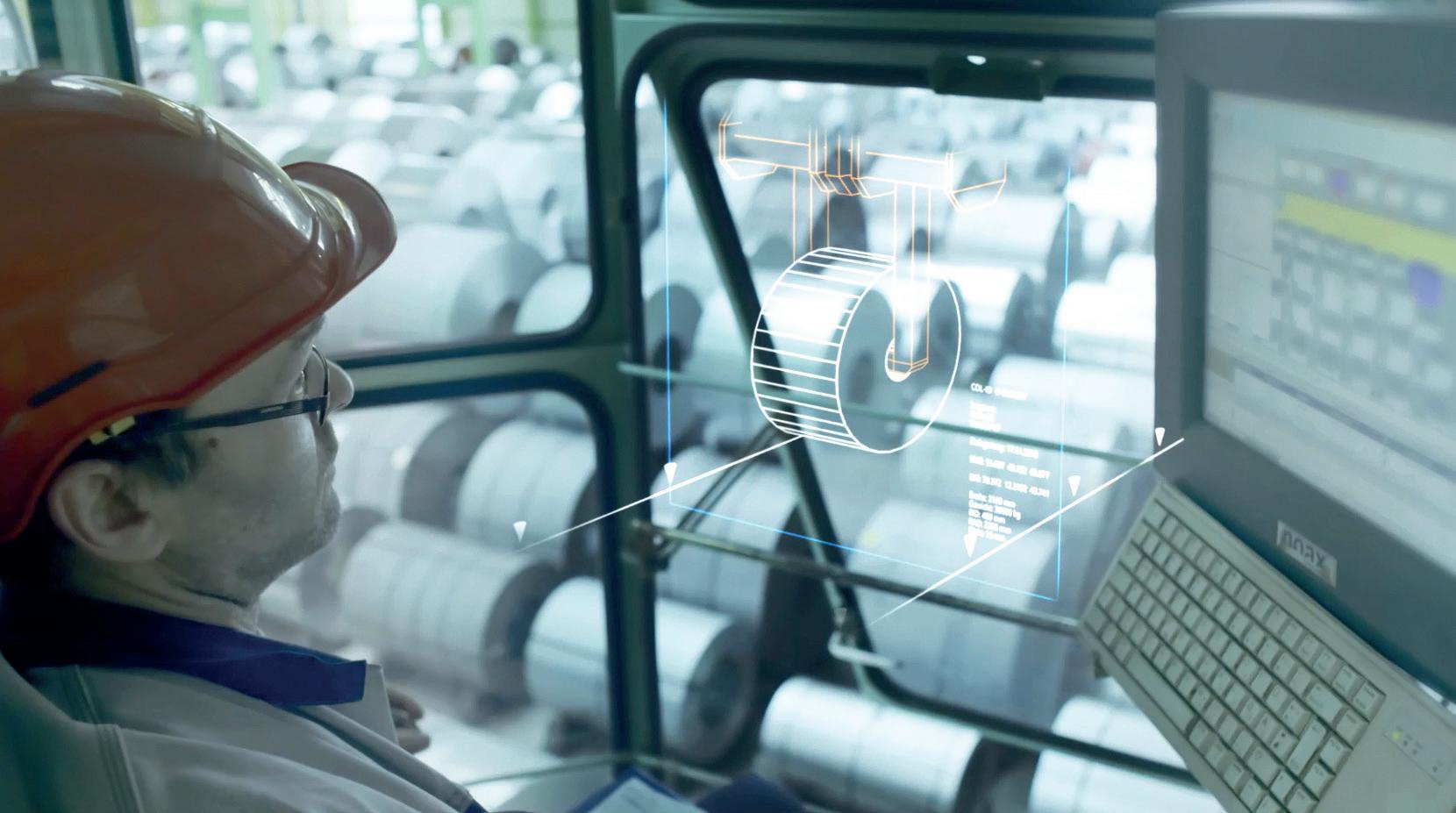
Tailored to the needs of the steel processing industry, toii® is suitable for companies who are at any level of digitalization. Individual modules can easily
be used to fill existing gaps. However, the full potential of toii® is only revealed when several modules are combined. If all machines and IT systems are connected, they can communicate with each other. Production downtimes are significantly reduced. Dashboards that collect production data allow human workers to see all relevant statistics at a glance. This enables them to react quickly to any unforeseen problems.
In this way, even a relatively small investment in modules that can be easily installed during running operations offers the potential to save man-hours, materials and energy. One thing is clear: The more data is collected and the more plants are digitalized, the more savings can be realized. These savings come from automated processes, but also from better decisions based on real time data insights.
Energy efficiency: more is possible
The benefits of digital manufacturing do not end with the machinery. Companies also benefit in terms of energy efficiency (for example, with digital energy monitoring across sites) as only those who know their energy consumption can also reduce it. This is relevant both for site operators, who suffer from rising energy costs, and for customers, who increasingly want to know about the carbon footprint of their entire upstream supply chain. Currently, the reality is that many companies are still manually tracking energy consumption with selfmade tables – often at the less meaningful site level. The inefficiencies associated with
DIGITALIZATION 42 www.steeltimesint.com Digital Edition - August 2023
Software solutions for digital manufacturing help steel processing companies to use man-hours efficiently. © thyssenkrupp Materials Services
this are obvious: man-hours are spent unnecessarily to collect data, consumption cannot be broken down by individual items, and any inconsistencies (such as consumption values that significantly exceed empirical and planned values) are not identified at all or are identified too late.
A simple solution is the wide range of measuring devices available on the market, which can be easily installed and integrated into the ERP or MES system. This simple solution provides plant operators with real-time transparency of their consumption data. This not only lays the foundation for implementing an ISO 50001-certified energy management system, which many customers now require in their supplier code of conduct. It also gives operators the opportunity to identify savings and use them to develop further strategic and procurement goals.
The human factor: working efficiently thanks to digitalization
In addition to increasing plant and energy efficiency, employees must also be deployed as economically as possible. It is important here that working time is spent on value-adding activities and not on acting as a human interface between IT systems and machines. Once again, digital manufacturing can make a decisive contribution here: for example, by using MES such as toii® to automatically adjust machines to the next task, thereby saving resources. Feedback from production to the ERP system can also be automated.

The more efficient use of labour depends
on available data. Meanwhile, production processes that have been enhanced with digital tracking systems already make it possible to monitor KPIs in real time. If workforce productivity falls short of opportunities and expectations, companies can directly explore the causes. For example, if there is a need for additional tools to enable more productivity, they can be purchased early on. Training needs can also be identified and addressed. Incidentally, all of this not only has a positive effect on the company’s margins, but also fosters employee loyalty. After all, work feels best when it is noticeably productive and contributes to the company’s goals. In addition, the growing number of digital natives in the labour market expect modern and automated processes in the workplace.
Internal communication
Internal communication is also an important factor when implementing these types of changes. Employees must be onboarded carefully when it comes to any changes to familiar processes to ensure acceptance of the innovations. And while the optimally digitalized production facility looks different everywhere, one basic pillar is firmly anchored: the goal is efficient and flexible collaboration between humans and machines. The best way to achieve this ideal is to involve employees directly in the digitalization process. This not only increases acceptance, but ensures greater efficiency: Those who regularly perform certain tasks often know best how they can be done more efficiently. That’s why, by
involving employees, companies can ensure that digital solutions are truly user-friendly.
Harnessing potential
Careful use of energy, material and human resources is essential to increasing production efficiency in steel processing companies. To realize potential savings in these areas, the step-by-step implementation of digital manufacturing is key. Increasing efficiency with the help of digital tools that can move analogue operations (albeit incrementally at first) in the direction of IIoT and Industry 4.0 is the goal and solution.
Waste reduction
As a first step, companies should examine where they can start to reduce the waste of their resources. They do not need to completely transform their production in the shortest possible time. It makes more sense to take many small steps that initially create data transparency where previously there was darkness. Only when strategic decisions are based on a solid database can savings be realized in the long term. In addition, legal requirements in the area of sustainability will become more rigid over the upcoming years. By digitalizing and connecting processes, companies can prepare for this at an early stage – and do something good for the climate in the process.
The same motto applies when it comes to both climate change and intelligent digital solutions: Starting today is better than tomorrow. �
DIGITALIZATION 43 www.steeltimesint.com Digital Edition - August 2023
When manufacturing is digitalized and networked, companies save valuable resources such as materials, labour and costs – and can operate more sustainably at the same time. © thyssenkrupp Materials Services

44 www.steeltimesint.com Digital Edition - August 2023 *USA correspondent, Steel Times International From manual to digital DIGITALIZATION
WHILE the steel industry has been slower than certain other industrial sectors to embrace the technologies involved with the recent digital transformation, that is starting to change – with many steelmakers becoming more aware of what they can better achieve by using cutting edge, disruptive technologies such as artificial intelligence (AI) and machine learning (ML), as well as the Cloud.
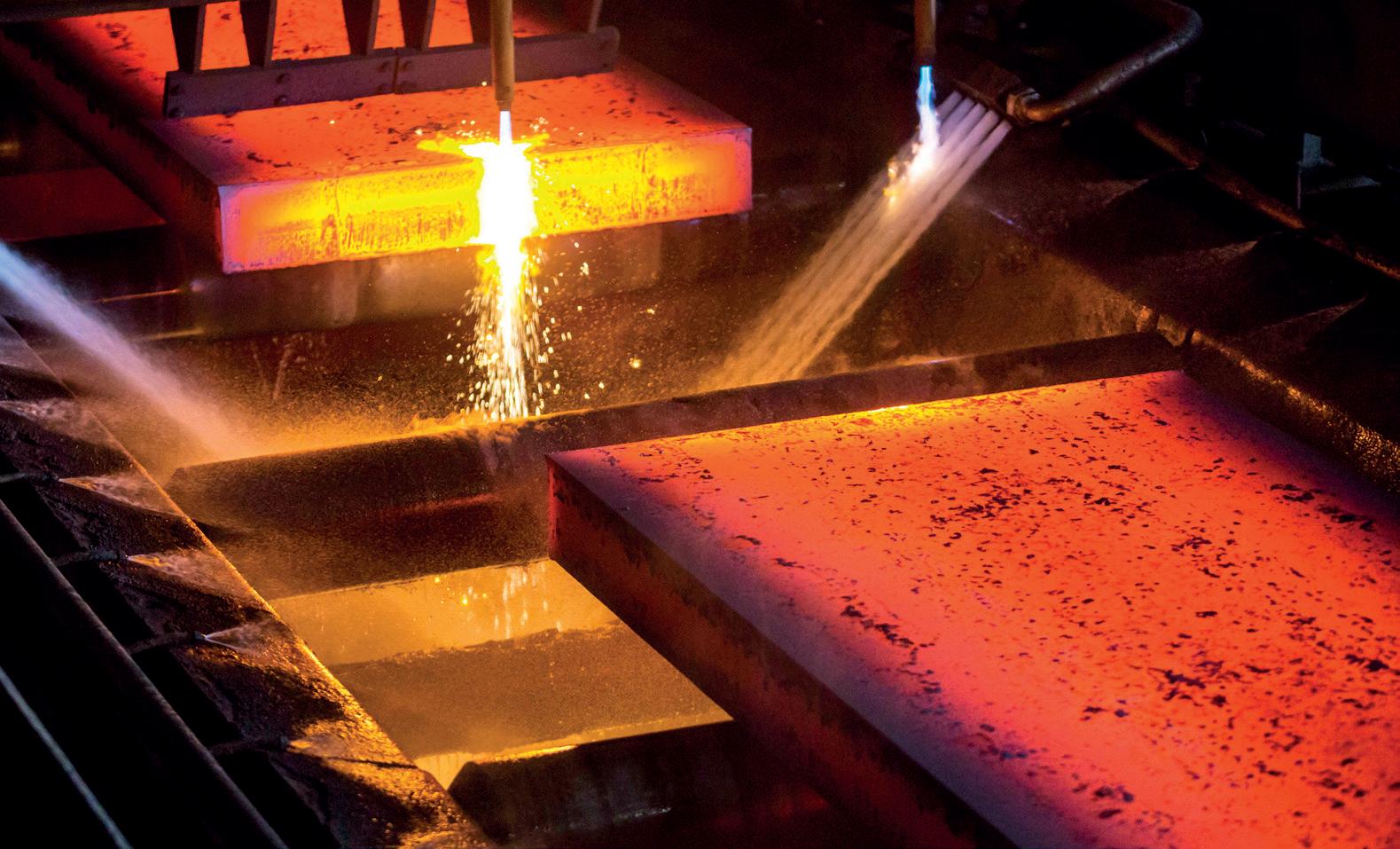
“It isn’t that the steel industry hasn’t already been digital for some time,” Michael Peintinger, Smart Steel Technologies’ Americas managing director, noted. “It has always recorded data. What has recently changed is its understanding of what to do with that data, how to analyze the data and use it to benefit their operations.”
the point where the Cloud has become the industry standard when just a few years ago many companies had been very reluctant to load their data there.
At the same time, Andrew Callaghan, managing principal at Crowe LLC said a number of companies are looking for ways that they can use generative AI technologies such as ChatGPT. Even at a time when the Federal Trade Commission is investigating ChatGPT over potential consumer harm, Callaghan says he believes there will continue to be increased excitement about generative AI given its ability to generate content like that a human can generate.
It has been a similar trend for the digital transformation and/or Industry 4.0 in general, Pamir Ozbay, head of
that these technologies can help it to achieve, including improving efficiency, product quality and cost points.
While some companies are further along than others, Ajikutira said that across the board there has been greater interest in increasing their process controls to achieve desired results. “To do that, [companies] are automating certain processes around quality, yield and maintenance,” he said, adding that doing so around maintenance is particularly advantageous, given that setting such equipment parameters could prevent breakdowns, therefore limiting downtime.
“Industry 4.0, which is seen as being the fourth industrial revolution, is a logical follow up to another industrial revolution – automation,” Smart Steel Technologies’ Peintinger said, noting that there continues to be more automation in steel mills, which, in turn has resulted in more data being recorded. “But what has changed is that this data isn’t only being manually analyzed by humans, as had occurred in the past, but [is increasingly being analyzed] through a technology-based approach,” with industrial artificial intelligence being used for certain solutions, including for process optimization, with an aim to improve efficiency and increasing surface quality. “It also allows steelmakers to make automatic, real time decisions regarding whether to downgrade the coil being produced,” he said.
In fact, Stefan Koch, the global metals lead for SAP, pointed out that overall, digital transformation is more of an evolution than a revolution, having not involved any totally new technologies, at least to some degree, for several years. But they are maturing and now more companies are willing to adopt them, Koch said, noting, “Technologies like AI and ML are no longer just being used by research and development institutions or in pilot projects, but are now part of companies’ normal information technology programmes relating to their standard business processes.
Also, Koch observed that it has gotten to
operations at Fero Labs (producer of AI driven manufacturing process optimization software) said, with the pace picking up considerably over the past three or four years with some companies being even more willing to share some of their data with customers and suppliers – something they had previously been reluctant to do.
Even though the steel industry has lagged behind some other sectors, Dinu Ajikutira, an AI solutions and innovation consultant with Canvass AI, said he believes that given that it is a very competitive industry, the steel industry is uniquely positioned for digital transformation issues. This, Ajikutira added, is due to its focus upon the things
At the same time, the use of robotics is increasing. However, Philip Gibbs, a senior metals equity analyst for KeyBanc Capital Markets, said that this is more the case for the steelmakers’ customers, such as automakers and parts producers, or steel distributors and processors, given that it is tougher to incorporate robotics in the steel mills themselves.
But there are growing instances of that happening at the mills as well, Fero Labs’ Ozbay noted, pushed by such factors as the workforce transition (with older workers retiring), lack of worker availability, and a desire for steelmakers to keep their workers safe by using robots or robotics in some dangerous parts of the plant.
The push for sustainability is another driver for the digital transformation, SAP’s Koch observed, noting that it is apparent, whether with the Inflation Reduction
DIGITALIZATION 45 www.steeltimesint.com Digital Edition - August 2023
With the increasing adoption of digital technology, the steel industry is shifting from a workplace that relies solely on human labour, to a data-driven and digitalized environment. By Myra Pinkham*
Act in the US or Green Deal in Europe, that everyone is excited about becoming greener. Koch added that steelmakers can’t become fully sustainable without the use of digital technology, which involves engineering tasks to improve steel production processes and to achieve more circular recycling.
This, Koch explained, is coming at a time when many end user customers, such as automakers, have been asking steel mills to verify what the recycled content of their products is and what steel components get recycled.
“This has made it quite tricky as you need to determine where to get the data, how to validate that data and how to make it auditable,” he said, adding, “There is the question of how to analyze that data to have the valid datapoints that the company needs to share, which can be a headache.”
But Koch noted that this presents an opportunity for technology companies given that the steelmakers (and others using these technologies) need to know how to
share the data they have collected with their partners, noting that this is one reason that SAP recently developed a sustainability data exchange.
Broadly, the steel industry’s use of digital technologies such as AI and machine learning is still in its early stages, Crowe’s Callaghan said, particularly given that many companies haven’t yet laid the necessary groundwork to generate data that is standardized and consistent.
It isn’t a question of having enough data, Peintinger noted, but rather a case of determining what data is relevant for the analysis of problems and how to analyze that data. “It is relatively new how that is being done,” he said, explaining that instead of doing manual root cause analysis, companies are now running real time models to predict what is going to happen next.
“While AI has been around for a long time, at this point much of its practical uses in the steel industry have been based upon trial and error and specific issues, and
therefore it hasn’t been used very broadly,” but rather by a few companies, such as the Big River Steel unit of US Steel, KeyBanc’s Gibbs observed, stating that he believes that at this time, the practical use of AI by the steel industry is yet to be determined.
“It is always natural for there to be some skepticism with new technology,” Peintinger said, but he said that as more results are achieved, the steel industry’s trust in these technologies is growing and that over the foreseeable future there will likely be an ongoing process of increased adoption of the technologies.
Companies have initially been targeting steel segments that promise a bigger return on investment, Peintinger said, adding that the goals that steelmakers have for using these technologies are similar to the types of goals they have always had – lowering costs, improving quality, and making production more sustainable – with artificial intelligence being used to stabilize the steelmakers’ production processes and production costs.

DIGITALIZATION 46
The goals that steelmakers have for these technologies – while varying company by company – have also been evolving. Koch said that while companies were originally looking to use AI and machine learning in production applications to increase their efficiency and quality and to reduce downtime, now they are also being used to predict costs and logistics issues, including whether items will be on time. Also, Gibbs noted that companies are using these technologies to determine where a company has gaps and holes in certain times of steel and to make better economic decisions.
This being said, several industry observers have warned companies to take it slow. In fact, Canvass AI’s Ajikutira said that one of the major reasons that AI/machine learning projects fail is that the company bit off more than they could chew, which he said that over time could cause bigger challenges than they had expected.
Callaghan said that another reason to start small is that many steelmakers don’t
have the necessary capabilities inhouse and need to find a data science partner. “It is a complex process for which there aren’t plug and play, off the shelf tools,” he said, explaining, “It takes expertise and good underlying technology to build the models to drive these AI and machine learning capabilities.
Describing it as a potentially multi-year journey, Fero Labs’ Ozbay said that most steelmakers usually start by incorporating AI, machine learning and other digital technologies into a specific area of a specific plant with the idea that once they get proven results that they could then try to use it in other areas of that plant. And then, once that plant tests out, they could potentially introduce it to their other plants. Ajikutira agrees, stating that this is why his company – like some others – has built its platform around providing modular solutions aimed at specific pinpoints. There are varying opinions, however, about how steelmakers choose to make inroads in using these technologies,
specifically if it makes more sense to do so in a greenfield mill, in brownfield expansions, or existing operations.
Gibbs said that he believes that these technologies are more likely to be used in a new mill because each year the technology gets a little bit better and steelmakers are going through a big technological investment period, building mills that have many more bells and whistles.
“You can’t have such mill investments without investment geared toward digital transformation,” he maintained.
But while he agrees that most of the latest technologies are going into the new greenfield steel facilities that are coming online, given that it is harder to upgrade existing plants than starting fresh, Callaghan said that there is also a path for steelmakers to go back and modernize some of their existing facilities.
Koch agreed that there is a trade-off. While there tends to be good deployment of machine learning in a greenfield plant with equipment makers having a certain amount of information technology associated with their hardware, there is a lot of historical data needed to support these technologies – which sits in various places in existing plants.
In fact, Ozbay maintains that it is that existence of historical data that makes the use of digital technologies in brownfield steel plants particularly advantageous given that it is historical data that is largely used to train AI systems, based upon past performance.
“The development of these digital technologies and their use anywhere in the steel value chain where there is a benefit to do so will continue to move forward,” Koch said, although it is a more gradual process in the US than in certain other parts of the world, including Europe and India, despite the impact of more companies looking to relocate to the US and of recent government stimulus packages, including the Inflation Reduction Act.
“Overall, digitalization is growing tremendously and will continue to do at an accelerated pace, going forward,” Ajikutira said, even though at this point steel’s data management remains less mature than that of some other industrial sectors. Despite this, Ajikutira summarized that ‘the pace that steel companies are adopting digital technologies has been growing,’ and will continue to do so as the technology advances. �

DIGITALIZATION 47 Digital Edition - August 2023
Measuring up
With the industry gearing up for Industry 4.0, Metallurgical Sensors, Inc. (Metsen) is continuing to provide systems for the ‘next technological evolution’, says Lucas Demysh*, ensuring production moves with the times.
1. How are things at Metsen? Is the steel industry keeping you busy? Yes, the steel industry is keeping us quite busy. Since Metsen was established in 1999, world crude steel numbers have almost tripled to 1900Mt from 850Mt (according to the World Steel Association). We are seeing steady growth in all sectors as industries are retooling for the modern age of net zero carbon emissions, which includes reducing energy consumption by improving their production efficiencies. Metsen provides the industry with custom sensor integration systems to measure and monitor process dynamics, and we continue to upgrade our products for the next technological evolution.
2. What is your view on the current state of the global steel industry? This is something we follow closely. War in Ukraine caused a spike, but the spike has dropped, and now we see the steel market beginning to taper off with less of a demand for the steel mill and potentially more time for maintenance needs. Steel producers can benefit from Metsen’s maintenance technology expertise because there is always a need to optimize yield and produce the highest quality steel possible.
3. In which sector of the steel industry does Metsen mainly conduct business?
Our focus is primarily on sensor integrations in ironmaking and steelmaking. Our products can fit the hot and cold sections, always emphasizing continuous improvements and increasing plant efficiencies.
4. Where in the world are you busiest at present?
Presently most of our business is conducted in North America. We are also receiving more inquiries from customers worldwide who are interested in our products and
services. All our systems are customizable, so they can be used globally regardless of the environmental demands or voltage required to power our systems.
In our eyes, both metals are strategically important. There is a fine balance between strength and weight, and we see that the automotive section has been continually researching the use of more lightweight materials for their components, such as aluminium. However, the saying ‘as strong as steel’ still has merit.
7. What are your views on Industry 4.0 and steelmaking, and how is Metsen using it?
There’s a give and take with the technology side of steelmaking because of the capital investment to upgrade a plant. We take a systematic approach by helping steelmakers tackle smaller changes first. Metsen’s EV Cam5 is a prime example. It is an analog camera that works with legacy technology and is designed with conversion for newer technology. We are also developing a camera with AI technology to capture data and images for future automated processing adjustments.
5. Can you discuss any major steel contracts you are currently working on?
In terms of contracts, we like working directly with our end customers. But where it brings value, Metsen is looking into distribution. Globally, we partner with distributors in production sites and plants to support the steelmaker’s technical requirements. We are also working in India, where there’s a heightened focus on the technology side of steel production, so we are putting resources in place to help grow our business there.
6. Where does Metsen stand on the aluminum vs. steel argument?

That’s an easy one. Both metals have unique properties, making each the preferred choice for a particular application. Designers will select the material that best suits the purpose of their design.
8. In your dealings with steel producers, are you finding that they are looking to companies like Metsen to offer them solutions regarding energy efficiency and sustainability? If so, what can you offer them?
Our customers look to us for productivity improvements, which inadvertently deliver energy efficiency. Metsen’s sensor technology helps steel producers increase yield and quality within fewer heats, requiring less energy. Sustainability is further addressed from the standpoint that our solutions eliminate guesswork. We work with metrics that steelmakers apply for continuous improvement and strongly believe in a continuous training programme.
9. Where does Metsen lead the field in terms of steel production technology?
PERSPECTIVES Q&A: METSEN 48 www.steeltimesint.com Digital Edition - August 2023
*CEO and chief technology officer, Metsen
Lucas Demysh
Metsen provides customer service. We deep-dive into a customer’s problem, develop a custom multi-sensor solution, fully integrate the system into their production process, and then provide continued support via our Remote Monitoring Management System (RMMS).
10. What are the greatest challenges in creating sensor technologies that make steel mills more efficient?
Extreme heat is one of the greatest challenges in creating sensor technologies for steelmaking. Almost all sensors require substantial modifications to make them reliable and durable. Another challenge is integrating our new technology into the customer’s limited or ageing infrastructure. Each site presents a unique experience for us, requiring an abundance of creativity from our team.
11. How do you view Metsen’s development over the short-tomedium term in relation to the global steel industry?
In the short term, Metsen continues to work with legacy technology while providing the onset for new technology. Since technology switchovers can be costly, we help steelmakers maintain their plants and build preventative maintenance plans. Our product implementation process allows for planned shutdowns with minimum downtime and disruption in the plant. As new plants are built in the mediumto-longer term, we are developing stateof-the-art solutions, such as a powerover-ethernet camera system and AI metrics-based vision systems.
12. What is Metsen’s experience with the Asian steel market?
Metsen has worked with steelmakers in Asia for many years, with India being an important market. In India, we see a push for green technology and competition on efficiencies and innovation. Metsen’s Slag Detection Systems (Vibration Slag Detection or Optical Slag Detection) and Absolute Length Measurement (ALM) Systems respond to the market’s needs. The ALM System offers laser technology coupled with a vision system, and the slag detection has a combination of vision systems coupled with accelerometers. Metsen’s custom-built software backs both systems.
13. Where do you see most
innovation in terms of production technologies – primary, secondary, or downstream?

Primary steelmaking benefits from innovation since it is the most energy intensive. Optimizing the production process in all sectors also reduces energy costs and emissions which are critical for the green steel initiative. We also see a lot of technology and innovation coming downstream. For example, when billets and blooms go through the continuous casting process and hit the cooling stage, they deform. There’s technology focused on preventing this from happening. Steel tracking is another downstream technology play.
14. How optimistic are you for the global steel industry, and what challenges face global producers in the short-to-medium term?
I am very optimistic to see the advancement of micro-mill technology, which means that steel mills can be located anywhere in the world where they are needed. Strategically located micro-mills will reduce the need for shipping steel long distances, addressing the current challenge of reducing fossil fuels consumed by transportation.
15. What exhibitions and conferences will Metsen be attending or participating in over the next six to 12 months?
We will attend the Conference of Metallurgists (COM) in Toronto in August, events associated with the Northern Chapter of AIST, and exhibit in Columbus,
Ohio, at AISTech 2024.
16. Metsen is headquartered in Canada, so what’s happening in the Canadian steel market?
Canada was ranked 17th in 2022 among the top 20 steel-producing countries, producing 0.68% of global steel production, a small percentage compared to the rest of the world, but some exciting things are happening here. First, a technology trend is developing in Canada, paralleling the trend across the steel industry. Producers are relying on and incorporating more data and metrics than ever before. But probably the most exciting development is Ontario’s Ring of Fire region, where some of the most promising mining for critical minerals to support a low-carbon future, such as nickel, cobalt, copper, chrome, platinum, and palladium, is happening. Metsen supports the sensor technology, data acquisition, and data processing needs of major mining operations across Canada.
17. Apart from strong coffee, what keeps you up at night?
I am driven by innovation and delivering the highest quality products with an almost infinite service life. I also want to grow awareness of Metsen’s brand and our reputation for service excellence.
18. If you possessed a superpower, how would you use it to improve the global steel industry?
My superpower would be a backup AIpowered brain that generates solutions for the global steel industry when I’m asleep. �
www.steeltimesint.com PERSPECTIVES Q&A: METSEN 49
Pictures of history
Artists throughout time have chronicled the extraordinary and often unseen activities in the furnace, depicting intricate details of the metallurgical process. By Tim Smith*
IN the Uffizi gallery in Florence, a picture hangs catalogued as ‘Landscape with Mines’ by the Flemish artist Civetta, dated 1525. In fact, it illustrates far more than mining as there is a blast furnace in the centre – which I have numbered [1] and a forge to the left [6 and 8] as well as mine shafts [5]. Civetta, also known as Herri met de Bles, was a native of Bouvignes in the Walloon region of present-day Belgium, where presumably he painted this landscape.

The blast furnace has a thatched roof and flames can be seen emanating from the top of the square furnace shaft. We have no records of how often the thatch caught fire. The bellows are powered by an overshot water wheel and the wheel race flows under the track through an arched stone culvert [9]. The furnace casting arch is evident to the right of the water wheel and contains a large ‘sow’ recently cast. Another sow – weighing up to a ton – is being
carried [3] to a pile [2] in the foreground by eight people, one of whom appears to be a woman. There is a steep hill above the furnace, necessary to gain access to the top of the furnace to charge it. The end of a building to the right of the furnace [4] could well be the charcoal store.
The illustration of the forge shows two hearths, one with a chimney above it [6] and bellows to introduce air [7]. This is typical of a Walloon forge which has two hearths.
*Consulting editor, Steel Times International, honourable secretary, Wealden Iron Research Group
HISTORY 50 www.steeltimesint.com Digital Edition - August 2023
The finery hearth lowers the carbon content of the cast iron sow by ‘burning off’ carbon. Since the sow is large, it is progressively fed into the finery through a hole in the building’s wall behind the finery so that the tip of the sow is oxidised by the air from the bellows to lower the carbon content. This renders the brittle cast iron malleable.
The refined ‘loop’ of iron is then transferred for consolidation under a water powered hammer [8], and drawn out into a bar of wrought iron. This requires several reheats in the second hearth (beyond the hammer in the picture) known as the chafery.
A rather spindly ‘spider’ appears to be
the mechanism for blowing the bellows for the forge which would have levers fitted with counter-weights to reopen them following compression by a cam on an axle driven by a water wheel. Possibly, for artistic licence, the hearths are shown as exposed in the front of the forge, rather than inside the building where darkness aids the process by observing the colour of the flame and metal. Highlighted by the left hand hearth is the forge hammer – a rather small looking piece of equipment, maybe the artist’s attempt to produce perspective. A heavy water wheel-driven shaft would operate the hammer via cams. Finally, can you find the owl hidden in the very bottom left corner, the trade mark of the artist?
The description of the picture in the Uffizi is of ‘iron mining; and the media, oil on canvas’ inventory number 1890 No 1051. It came from the Medici collections probably as a result of Francesco I’s interest in raw materials and mining.


Civetta was not the only artist to capture industrial scenes of this kind. 60 years later, in 1585, Martin van Valckenborch, a Flemish Renaissance painter, born in Leuven, in present-day Belgium, painted ‘A River Valley with Iron Smelter’. He, and his brother Lucas, painted several versions of ironworks. These have been digitised and a link to these, and other industrial scenes, provided through the Grohmann Museum at the Milwaukee School of Engineering. Sound effects and a commentary have been added to a number of the pictures which can be viewed on-line
at https://artsandculture.google.com/story/ rAWhpwJ2KKV6KA
The opening page shows the above picture, illustrating a blast furnace bottom right on the river bank. This clearly shows the furnace shaft with only lean-to shelters for the casting arch to the left and the water wheel-driven bellows to the right. Other Valckenborch pictures of a similar scene show that ore is brought across the river by boat. The forge is central in the picture and depicts two water wheels typical of a ‘German’ forge which used a single hearth for both refining and reheating. One wheel drives the bellows for the hearth and the other the hammer to consolidate the refined metal. Clicking on the bottom arrow zooms into the furnace.
Clicking through the pictures will take you to a second picture by Lucas and Martin van Valckenborch ‘Fantastic River Landscape with Ironworks’, showing a forge to the left of the picture, but incorrectly uses the same commentary as the previously described Valckenborch picture. There is no blast furnace evident in this picture.
Should you progress further through the collection you will come again to a Valckenborch illustration of an ironworks on the Meuse River in the Netherlands dated 1611, a year before Martin’s death. Here, mining of ore from pits is in the fore, bottom right, the furnace is shown bottom left and the forge beyond that. A further forge is seen in the distance.
Such illustrations capture the technology of the early days of the blast furnace. �
51 www.steeltimesint.com Digital Edition - August 2023 HISTORY
Landscape with Mines by Civetta (1525 – 1527)
















































































































































































































































































